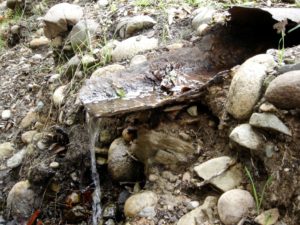
* Over 600 acres of Rocketdyne drain into Brandeis-Bardin and adjacent Runkle Canyon
* 1993, 1995 Rocketdyne reports show 19 elevated Strontium-90 soil sample readings
* Plutonium-239/240, Uranium-238 found in 2004 soil higher than later SSFL readings
* Elevated Strontium-90, beta radiation in 2005 water flowing into Brandeis-Bardin
* 2012 EPA soil and Boeing groundwater Area IV reports consistent with earlier results
* Nov. 2015 DOE finds rads identified as “fission products” and “used in reactor control rods”
* Nov. 2016 NASA report shows Brandeis-Bardin groundwater/wells chemical contamination
* Dec. 2016 DOE report given by camp owner American Jewish University (AJU) to Jewish Journal shows elevated Brandeis-Bardin soil toxins
* Brandeis-Bardin reports released by AJU show perchlorate in fruits and vegetables
* AJU denies all contamination in 2015, 2016, March 2017
* Dec. 2016 DTSC letter claims no SSFL rads migrated north, DTSC maps show otherwise
* Jan. 2017 DOE issues Draft Environmental Impact Statement (DEIS) proposing little cleanup
* Ventura County Board of Supervisors, Los Angeles County Board of Supervisors, Los Angeles City Council pass resolutions critical of DOE’s DEIS
A 13-year-long investigation of the Brandeis-Bardin Institute has revealed extensive radiation and chemical impacts across the 2,878 acre property in eastern Simi Valley, California. Multiple government and media tests and reports from 1993 through 2016 indicate that the site may have been contaminated by the bordering Santa Susana Field Laboratory (SSFL), commonly known as Rocketdyne.
Read more at BRANDEIS-BARDIN’S TOXIC DENIAL INVESTIGATION
Photos, videos, reports, figures, tests, data and special analysis
The Brandeis Camp Institute began in 1947 on 2,200 acres in eastern Simi Valley and by 1953 Camp Alonim (“oak trees” in Hebrew) was established. The camp soon became a new paradigm in Jewish adult and youth retreats for “a non-denominational, Jewish experience brought to life through sports, the arts, nature, and learning in a safe and embracing community,” according to its website. In 2007, the 250-student Bel-Air based University of Judaism merged with the institute resulting in the American Jewish University (AJU) and its Brandeis-Bardin Campus.
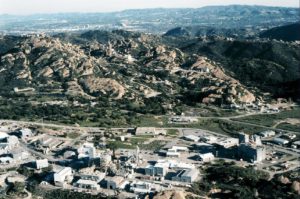
Recent media coverage of Brandeis-Bardin’s radiation and chemical issues, greeted with a howl of indignation by camp owner American Jewish University (AJU), has set the stage for this exposé which fully documents contamination findings and impediments to full cleanup.
“Sludge from Rocketdyne”
Lab tested soil and water samples from Brandeis-Bardin show that elevated levels of radiation. Plutonium-239 (Pu-239/240) and Uranium-238 (U-238) were found in the Jewish camp at levels even higher than they are at SSFL’s Area IV, according to soil tests from 2004 and water readings from 2005 that have been authenticated and verified by EnviroReporter.com.
Area IV is the 280 acre nuclear research part of SSFL, much of it draining into Brandeis-Bardin. Operated for decades by the Atomic Energy Commission and then the Department of Energy (DOE), and owned by Boeing, it is the site of three partial nuclear meltdowns including the Sodium Reactor Experiment in 1959. Area IV is grossly polluted by radiation and chemicals.
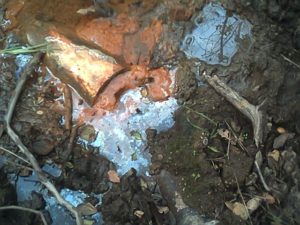
Tests were conducted for soil on December 30, 2004 and for water on November 23, 2005 from mud and a bubbling, chemical sheen-topped liquid at the bottom of a ravine in the upper reaches of Meier Canyon at the camp. Samples were subsequently sent for radiochemical analysis to STL Richland, a prominent Richland, Washington-based laboratory.
The 2004 STL Richland soil test results had to wait eight years before they could be compared to a reliable standard. The dirt’s radionuclides were then compared to “Background Threshold Values” (BTVs) developed for Area IV by the U.S. Environmental Protection Agency (EPA) in 2012. The government’s tests cost taxpayers $41.5 million and found high radiation as reported in Radiation Readings Soar at Rocketdyne.
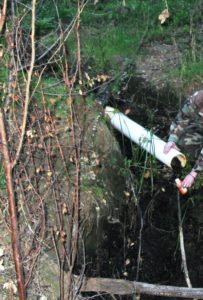
Area IV’s Former Sodium Disposal Facility (FSDF) drains down Channel D into Meier Canyon where the toxins were detected. The FSDF was used to dispose of barrels of radioactive sodium. Sodium reacts violently with air or water so workers would take lots on who would get to shoot the barrels with a rifle to make them explode outdoors. Debris was blown in all directions including down into Brandeis-Bardin according to an eyewitness account from a former Rocketdyne security guard recently recalled to EnviroReporter.com.
Gurgling goo was still flowing unimpeded in the exact same Meier Canyon location in 2014 when Simi Valley resident Brandon Manwell contacted EnviroReporter.com. Manwell had found the place hiking with friends. He videotaped and photographed it in April 2014 and the result is a YouTube video entitled Sludge from Rocketdyne. The skateboarder first thought he was in the upper reaches of Runkle Canyon, one mountain ridge away to the west, where KB Home’s controversial development called Arroyo Vista at the Woodlands is being built.
“Me and my friend found a few places just like this back in that canyon,” Manwell wrote in an April 19, 2014 email to EnviroReporter.com. “We wouldn’t have thought too much of it except for the fact that the water running out of this old pipe was iridescent, kind of like when water has oil in it, but it had a weird consistency when we touched it with a stick in the video. We weren’t sure what to make of it to be honest, we thought we should go back and get samples.”
Read more at BRANDEIS-BARDIN’S TOXIC DENIAL INVESTIGATION
Photos, videos, reports, figures, tests, data and special analysis
The 2004 and 2005 STL Richland radiological testing isn’t the only data available showing Brandeis-Bardin pollution detections. A DOE map showing chemical contamination reaching far into Brandeis-Bardin that is marked for possible remediation was shown at a public meeting April 22, 2014. That map listed offending chemicals on Brandeis-Bardin property which included dioxins, poly aromatic hydrocarbons (PAHs), phthalates and pesticides.
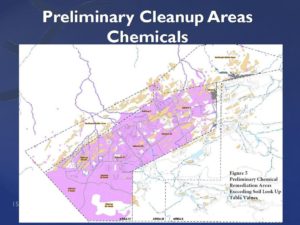
At the same meeting, DTSC officials straight-faced told the audience that SSFL pollutants were staying onsite, above and below ground. But the department later made public more information that confirms what the DOE and DTSC maps had already shown, this time with diagrams carefully plotting toxic trouble spots in the upper reaches of Brandeis-Bardin.
DTSC sent to EnviroReporter.com December 3, 2015 a Boeing report including maps of Brandeis-Bardin contamination [pp. 55-57/138 PDF pages; 10.89 MB] down what is called “Channel D.” This 2008 report explains that Boeing owns Area IV and the Northern Buffer Zone (NBZ), land transferred to Boeing in 1997 as part of the confidential settlement with Brandeis-Bardin over the camp’s land allegedly being contaminated.
The maps show at least eight chemically-impacted places in Channel D on Brandeis-Bardin property that would be cleaned up applying the standard that the DOE and NASA have committed to with DTSC in 2010, normal background. Boeing’s report suggests that’s unreasonable and recommends a drastically smaller cleanup, which is shown on its own map as removing from remediation the eight chemical hot spots in Channel D on Brandeis-Bardin’s property.
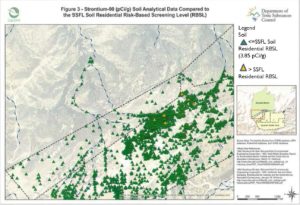
Problem was that the standard of 3.85 picocuries per gram (pCi/g) for Sr-90 that it used, apparently provided to DTSC by Boeing, was thousands of times less protective than the current EPA Residential Preliminary Remediation Goal of 0.00121 pCi/g. DTSC falsely declared almost of all the Strontium-90 in Area IV to be to be less than a residential risk-based standard, when in fact they are almost all above it. DTSC also should not have applied any risk-based standards to Area IV, since it is under the Administrative Order on Consent (AOC) to be cleaned up to background. (DTSC signed identical AOCs with the DOE and NASA in 2010 agreeing to remediate their areas of SSFL to background levels of radiation and chemicals under state authority.)
The maps strikingly, visually, and directly contradict recent statements by both AJU and DTSC. AJU has linked to just one page of that April 2016 presentation on its website, neglecting to include the maps that were in the very subsequent pages. Not to be outdone, in a December 22, 2016 letter to California Assemblymember Matt Dabaneh, DTSC claimed that, “there was no migration of radiological contamination north of SSFL.” This “nothing to see here, keep moving along” approach flies in the face of hard data, reports produced by DTSC itself, and established EPA regulations.
A November 2016 NASA groundwater report obtained by EnviroReporter.com also shows chemical contamination in a Brandeis-Bardin artesian well discharging water down a canyon, with toxic levels detected that exceed California Maximum Contamination Levels (MCLs) for drinking water. All water courses draining through Brandeis-Bardin, perennial and non-perennial, are considered ‘blue line streams’ protected by the Clean Water Act. The MCL overages in Brandeis-Bardin should, normally, be reported to the Los Angeles Regional Water Quality Control Board (LARWQCB). EnviroReporter.com has found no evidence that any such notification about Brandeis-Bardin’s MCL exceedance were ever reported to the board.
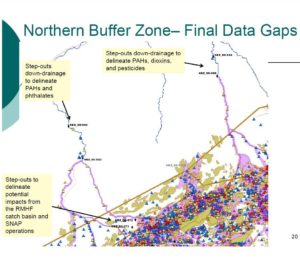
EnviroReporter.com has also uncovered additional evidence of SSFL toxins impacting the Jewish camp including 1993 and 1995 Rocketdyne reports showing Sr-90 over background in 19 separate soil samples. Cesium-137 was found in a NASA drainage into the camp and radioactive cow flops in Area IV were so hot that they threatened to re-contaminate the FSDF after one of its remediations. Camp videos feature revelers playing traditional Jewish instruments dancing near the potentially hot heifers.
None of this should be unexpected. Brandeis-Bardin borders and is in the drainage of the former Sodium Reactor Experiment (SRE) which partially melted down and released hundreds of times more radiation outdoors than did Three Mile Island in 1979 from the unfortified building. The SRE site and its surroundings still have massively contaminated areas with radiation at thousands of times background.
Radiation in the Dirt
When first found in 2004 at the bottom of a ravine under Area IV, the suspect substance looked as if it had been coming out of the pipe and ground for years. Based on eyewitness observations, photographs, videotape, and Rocketdyne and Boeing reports, EnviroReporter.com estimates that the liquid leaking into Meier Canyon Creek and flowing through Brandeis-Bardin has likely been in existence for decades.
The sampling site sits about 1,200 feet downhill of the Radioactive Materials Handling Facility (RMHF), the former SNAP experimental space nuclear reactors and the FSDF. Small space reactors partially melted down in Area IV in 1964 and 1969 releasing radiation into the environment.
The entire 2,850-acre mountaintop lab drains 612 of its chemically and radioactively impacted acres into Brandeis-Bardin. The AJU property is the largest Jewish-owned institutionally owned property outside of Israel. Ironically, it borders the lab which was started to test V-2 rockets under the guidance of the former Waffen SS-Sturmbannführer (Major) and rocketeer, Wernher von Braun.
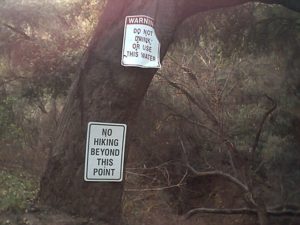
Pu-239/240 was found considerably higher in the Brandeis-Bardin dirt tested than the highest sample analyzed in the EPA’s 2011 radiation soil testing report in Area IV. A potent radionuclide with a half-life of 24,110 years, Pu-239/240 was collected and tested in a 2004 Brandeis-Bardin soils report [17 PDF pages; 805 KB] completed in 2005 by STL Richland. Both soil samples had higher Pu-239/240 than found in Area IV soils.
The peak 2004 Pu-239/240 sample exceeded its BTV by 55.2 percent. This extremely toxic, cancer-causing radioisotope produced during a nuclear reaction was precisely 21.6 percent higher than the “Maximum Value Detected” (MDV) for the radionuclide found in Area IV in the EPA’s October 2011 Final Radiological Background Study Report – SSFL [PDF page 282/286; 16.5 MB].
Read more at BRANDEIS-BARDIN’S TOXIC DENIAL INVESTIGATION
Photos, videos, reports, figures, tests, data and special analysis
Plutonium-239 is a nuclear reactor byproduct that has been called one of the most toxic substances on the planet due to its lethality and use in nuclear weapons. With a half-life of 24,000 years, it also hangs around for a very long time.
Rocketdyne and its successors have repeatedly denied the presence of Pu-239/240 on Brandeis-Bardin property, first in the 1995 report Additional Soil and Water Sampling – The Brandeis-Bardin Institute and Santa Monica Conservancy [535 PDF pages; 11.9 MB]. “Isotopic plutonium was not detected in any of the field samples collected during the study.”
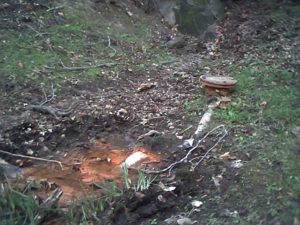
“The field lab sits at a higher elevation than the Brandeis-Bardin, any third-grader can tell you how the Plutonium 239/240 and Uranium 238 migrates offsite onto the camp,” said William Preston Bowling, founder of the SSFL-themed Aerospace Contamination Museum of Education, in a January 19 email to EnviroReporter.com. Bowling first came upon Brandeis-Bardin’s warning signs in Meier Canyon in 2007 as well as the water dribbling into the creek, as evidenced by this article’s cover photograph. “The sad thing is, the camp owners know about the contamination, even going as far as putting up signs – Do not drink or use water – they would rather put people at risk than upset their “Cash-Cow” aerospace neighbor.”
The 2004 soil from Brandeis-Bardin showed substantially elevated beta radiation in both samples according to background numbers for California developed by the nuclear experts at U.C. Berkeley’s Department of Nuclear Engineering. The highest gross beta soil sample reading was 2.18 times higher than background for this kind of ionization, the measurement of which is used to determine if man-made radionuclides are impacting a tested medium.
Alpha radiation in the camp’s 2004 sludge also came in at over two times the median average according to a U.C. Berkeley nuclear expert’s “range of gross alpha.” Alpha radiation is between 20 to 1,000 times more dangerous to the human organism than other radiation due to its “relative biological effectiveness” in causing cell-death and cancer according to numerous sources.
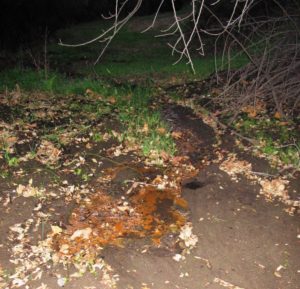
“Regarding the Campsite Area I drainage, please acknowledge the limitations of that work,” radiation physicist Joel I. Cehn says in the report, critiquing its inadequacies. Cehn has been Brandeis-Bardin’s an environmental contractor for decades. “There is a 1,200 ft. gap between the lowest soil sample at the top of the hill (BB-17) and the highest soil sample at the bottom (BB-20). This area was not explored. Thus, we cannot confirm that only one ravine is involved, nor how far down the hill the contamination extends. Recall that both tritium and Cesium-137 were detected at the bottom of BB-17. Samples further down the hill could not be collected due to steep terrain, resulting in this 1,200 ft. gap.”
The 1995 report showed that tests at BB-03 in 1994 found both Cs-137 and Sr-90 that would be substantially over background values derived by the EPA in 2011 and published in 2012. A Cs-137 sample radiated 65.9 percent over its background. The tests provided to EnviroReporter.com a decade later showed it was still there lending credence to the likelihood that Cs-137 and Sr-90 may still plague the Campsite Area I site.
Radiation in the Water
The chemical sheen glossing the camp water was sampled and analyzed in 2005 from the same unmarked canyon as the 2004 soil test. The 2005 Brandeis-Bardin water report [13 PDF pages; 355 KB], completed in 2006, found Sr-90 over double both the Los Angeles and national averages and Pu-239/240 at nearly half as high as the highest Pu-239/240 pulled and tested in Area IV groundwater by the EPA.

Beta radiation in the 2005 water was over double the national average in drinking water supplies derived by data provided by the National Research Council (US) Safe Drinking Water Committee. Beta radiation is often associated with man-made radionuclides like Cs-137 and Sr-90.
Read more at BRANDEIS-BARDIN’S TOXIC DENIAL INVESTIGATION
Photos, videos, reports, figures, tests, data and special analysis
Brandeis-Bardin’s water woes aren’t limited to the 2005 report acquired by EnviroReporter.com. The story of the so-called Brandeis-Bardin “bathtub well” includes DTSC exposing huge amounts of radiation in Brandeis-Bardin water in 2012 and then state agencies trying to disprove it in 2014 and beyond.
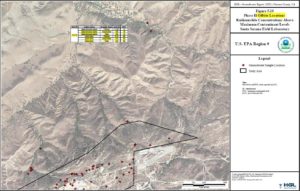
A joint DTSC/LARWQCB PowerPoint presentation May 21, 2014 [38 PDF pages; 3.44 MB] included a revision to the high alpha and beta radiation readings found in the bathtub well, perhaps because the high radiation caused a stir when EnviroReporter.com first reported on it in its May 23, 2012 exposé Runkle Roulette.
“USEPA was granted access to an offsite well on the Brandeis-Bardin property,” the article read. “There, at OS-10, the agency detected beta radiation in the well water at nearly three times its MCL for drinking water. Total adjusted gross alpha radiation activity was 8.61 times its MCL which is even more troubling: alpha radiation is up to 60 to 1,000 times more dangerous than beta or gamma radiation because of the harm it causes upon ingestion or inhalation.”
According to the government’s revisionism in the presentation, the bathtub well was too turbid with suspended solids to give an accurate reading of the water. “The elevated levels of the suspended and total gross alpha and beta are attributed to the very high turbidity of the sample and is considered to be a result of naturally occurring radionuclide [sic].”
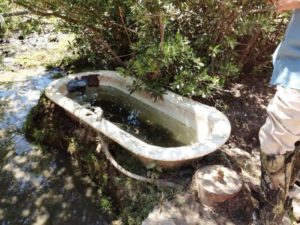
But even more obviously, the photo shows clear water running out of a hose into the tub, keeping it filled and overflowing it. Any competent agency should know to take the sample from the hose, not the tub. Or both.
The last part of the sentence quoted preceding says the sample “is considered to be a result of naturally occurring radionuclide [sic]” which begs the question of why LARWQCB and DTSC didn’t test the water with a gamma spectrometer to determine, not ‘consider,’ what is making the water so hot? By not determining the radionuclides causing the high readings, no fingers could be pointed at the most likely source radiating higher up in the Simi Hills. This unsound science also shortchanged anyone at Brandeis-Bardin who might have cared about watering their livestock with exceptionally radioactive water.
Plutonium Pipeline?
The conclusion that the bathtub well showed no man-made radiation was and is part of DTSC’s mantra that no SSFL contaminants have gotten offsite. Straight faced at years of meetings, DTSC officials essentially maintain that chain-link fences somehow prevent the huge amounts of radiation and chemicals at SSFL from leaving their mountaintop compound.
Rocketdyne got into the act as well nearly twenty years before DTSC began its denial campaign. According to its McLaren/Hart report on Brandeis-Bardin for Rockwell International in 1995, a year before Boeing bought Rocketdyne, this higher than normal bathtub well radiation shouldn’t be there at all.
“No radionuclides were detected above measure background in any of the human activity areas at either the Conservancy or Brandeis-Bardin,” the report says. “Radionuclides were not detected in groundwater in the two private wells that were sampled.”
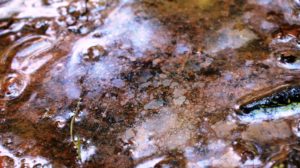
Boeing weighed in on potential Brandeis-Bardin contamination with a July 29, 2008 paper entitled Plutonium-238 at Brandeis-Bardin [26 PDF pages; 4.65 MB]. “It should be noted from Appendix D that all samples were non-detect for plutonium-239 which is the plutonium isotope usually associated with nuclear reactor operation,” the paper says.
Yet Plutonium-239/240 was detected in both Brandeis-Bardin soil and water in 2004 and 2005. Analysis of the scant original Brandeis-Bardin environmental documents AJU has released since the 2015 KNBC investigation began failed to reveal any testing for Pu-239/240 let alone detecting it.
It’s not just Area IV that may be leaking radiation downhill into Brandeis-Bardin. Nor is it just radiation. William Preston Bowling joined in discovering black and grey blocks of lung-destroying asbestos in one of the main drainages into the camp in 2007 – blocks that stood taller than he did along with broken pipes with the toxic heavy metal antimony.
“The remediation began after the state’s Department of Toxic Substances Control (DTSC) issued lab owners Boeing and the NASA an Imminent and Substantial Endangerment Order on Nov. 1 for the cleanup of asbestos-containing material strewn along the creek bed from 1965 to 1978 by lab workers working at the former NASA liquid oxygen plant (LOX) nearby,” states the article Cleaning Up Rocketdyne in the November 21, 2007 Ventura County Reporter.
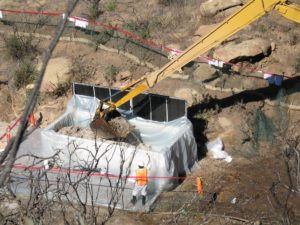
And that wasn’t all. Boeing was forced to remove contaminated soil in 2009 on the NASA part of the lab at Outfall 009 which leads down to the main eastern drainage into Brandeis-Bardin.
“The Boeing Company, on behalf of NASA, is currently preparing to excavate soil at Outfall 009,” wrote Boeing’s SSFL radiation manager Phil Rutherford to the chief of the Radiologic Health Branch of the California Department of Public Health September 11, 2009. “This soils is being removed in order to mitigate NYPDES [National Pollutant Discharge Elimination System] storm water runoff exceedances of dioxins and heavy metals.” [sic]
Read more at BRANDEIS-BARDIN’S TOXIC DENIAL INVESTIGATION
Photos, videos, reports, figures, tests, data and special analysis
The contaminants sloshing down into Brandeis-Bardin during infrequent rains also contained radioactive contamination that Boeing had to dig out of the NASA soil. A NASA document obtained by EnviroReporter.com shows that the radionuclide Cesium-137 was found in five areas in the heights above Brandeis-Bardin. The highest hot soil had Cs-137 at 3.4 times background, which was dug out and sent to the low-level radiation dump US Ecology in Grand View, Idaho in 2013.
A Troubled History
NASA owes its very genesis to Wernher von Braun who oversaw the Mercury and Gemini programs and developed the Saturn V rocket that took America to the moon. The secretive SSFL site was set up to test the V-2 war rockets that von Braun had developed for Nazi Germany in World War II.
“[A] deep depression separating a circular arrangement of hills became the site of Rocketdyne’s first three test stands,” says a 1987 Rockwell International booklet entitled The Hill. “As direct copies of test stands that had been in use at the German WWII test facility at Pennemunde, they were designed to hold not only the engine to be tested, but the entire vehicle as well.”
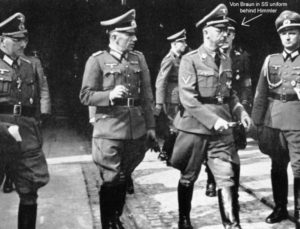
These first rocket stands erected at the SSFL were built at the Bowl Test Facility, or “Bowl,” as reported in the 2009 EnviroReporter.com article Bowled Over. “Thanks to the Nazi designs brought to the U.S. after the war by SS officer and rocketeer Wernher von Braun, these three stands built in 1949 played a crucial role in America’s burgeoning rocket program.”
A chance encounter with a former Rocketdyne employee at a February 5, 2014 SSFL Work Group meeting revealed more about the lab’s Nazi rockets origins. Taking a vape break during the meeting, a former worker of 30 years named Don told this reporter that von Braun’s original rocket test stand was not built from scratch plans. “They took it apart in Europe and shipped it over unassembled,” he said. “It came in mahogany boxes with Nazi swastikas emblazoned on them.”
“Von Braun’s V-2 rockets slaughtered 7,250 military and civilian personnel in World War II, mostly in London and Antwerp, Belgium,” reported EnviroReporter.com in the 2014 piece High Stakes for Hot Property. “Production of his lethal rockets cost 20,000 Mittelbau-Dora concentration camp inmates their lives with 9,000 dying from exhaustion alone. About 350 of these Nazi slaves were hanged, including 200 for sabotage, with the remainder shot or dying from disease and starvation.”
One French resistance fighter enslaved at von Braun’s rocket works was Guy Morand. In 1995 he testified that he was nearly executed by von Braun in 1944 after a supposed sabotage attempt. “Without even listening to my explanations, [von Braun] ordered the Meister to have me given 25 strokes…Then, judging that the strokes weren’t sufficiently hard, he ordered I be flogged more vigorously…von Braun made me translate that I deserved much more, that in fact I deserved to be hanged…I would say his cruelty, of which I was personally a victim, are, I would say, an eloquent testimony to his Nazi fanaticism.”
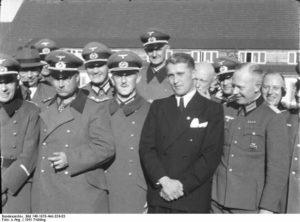
The morality over using suspected Nazi war criminals by the United States in an effort to best the Soviet Union did not end with America’s rocketry program. A 600-page Justice Department report released in 2010 that was suppressed by the government for four years revealed that America served as a “safe haven” for nearly 10,000 Nazis after the war. Surpassing the Soviets in space clearly trumped any qualms about using a possible Nazi war criminal with concentration camp prisoners’ blood on his hands.
Southern California’s Nazi history doesn’t end with the origins of the Santa Susana Field Laboratory. Less than 20 miles away is a Nazi lair that this reporter first wrote about for Los Angeles magazine in a 1996 article entitled Murphy Ranch.
Yet for all this actual Nazi history in Southern California, there is nothing about either Wernher von Braun or SSFL or Murphy Ranch in any of the predominate Jewish institutions in Los Angeles dedicated to remembering the Holocaust. Nothing in Brandeis-Bardin’s literature or online history mentions the Nazi-made rocket stand that loomed high in the Simi Hills above the Jewish camp for years belching smoke and pollutants during test firing.
Rocket Smoke and Gunsmoke
Dr. Shlomo Bardin founded the Brandeis Camp Institute (BCI), naming it after Louis D. Brandeis, the first Jewish Supreme Court Justice who provided the vision and funds for the programmatic enterprise, according to the BCI website. Bardin bought 2,200 acres of land in the hills above Simi Valley in 1947, a year before the U.S. government acquired 2,100 adjacent acres to secure secluded land for von Braun’s rocket testing.
“In 1953, Dr. Bardin established Camp Alonim (Hebrew for ‘oak trees’) as a residential summer camp for children, ages 8 to 16,” says BCI. “Camp Alonim provides a non-denominational, Jewish experience brought to life through sports, the arts, nature, and learning in a safe and embracing community.”
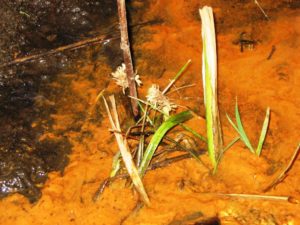
Rocketdyne replied that the water wouldn’t kill people but it could destroy vegetation and make livestock sick. Bardin apparently “insisted that Rocketdyne stop the pollution” according to the KNBC report, but nothing seems to have been done according to the documents and eyewitness accounts.
Indeed, untold numbers of hikers and campers made the heights under the lab their world to explore. EnviroReporter.com has obtained an old map that shows campsites at the bottom of the hill in Meier Canyon. One of them, as noted earlier, appears adjacent to the area of the 2004 and 2005 tests that detected Plutonium 239/240.
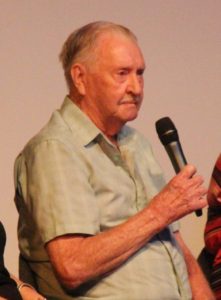
“A famous cowboy road his horse up to the property line and says ‘I’d like to speak to a supervisor’ and [the supervisor] says ‘What’s your problem, sir?’” Powell told the rapt Work Group audience of a story from 1962. “And he says ‘I have 28 head of dead cattle down here that drank water out of this pond.’ So he assumed it was runoff from this disposal pit which it probably was.”
Powell, who has suffered from extreme peripheral neuropathy, confirmed exclusively to EnviroReporter.com that the “famous cowboy” was indeed James Arness. Ten years later, Arness donated his land to Brandeis-Bardin. That included the working ranch and livestock.
“In 1972, the neighboring land owner, James Arness, star of TV’s still wildly popular Gunsmoke donated his 950 acres, making the Brandeis-Bardin property 3,200 acres,” according to AJU’s Brandeis-Bardin-based Camp Alonim website. “This is the second-largest piece of land held for Jewish communal purpose, second only to the State of Israel.”
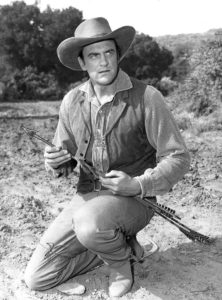
Over the years, cattle grazing in Area IV were becoming a problem for Rocketdyne. In a June 25, 1991 memo obtained by EnviroReporter.com, Rocketdyne honcho Steve Lafflam related that the cattle’s droppings were so hot that they were interfering with restoration of the FSDF.
“The cattle were identified as a source of RA [radiation] contamination by the DOE Tiger Team,” Lafflam wrote. “Too [sic] keep them we would have to start doing analysis on the animals. There is continually the evidence of “meadow muffins” in the “burn pit”. The Burn pit will be cleaned up by 12/92 (State Order) and then we could go back to the lease if we wanted to.”
The radioactive turds, surely dropped all over the place including Brandeis-Bardin where the Charolais cattle herd originated, came from the bovine eating hot vegetation and drinking hot water. Flora sucks up radioactive and chemical contamination in the soil which is eaten, in this case, by cattle which then spread it all over the place through their droppings. Radiation-tainted water would certainly have been accessible by these cattle.
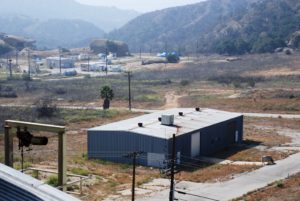
Nor is it known if the producers, actors and crews of numerous films, TV shows and commercial productions filmed at BCI were ever told of the environmental situation that they faced working there. An educated guess would be they were not. Many productions have been made at the camp including Jurassic Park, Star Trek VI, Melrose Place and Diagnosis Murder.
Ranch Radiation
The distinctive white cows still roam the hills as the AJU photo of white cattle shows in its The Land web page. An August 2012 Camp Alonim video features two men lightheartedly blowing on instruments in front of a couple of the cows.
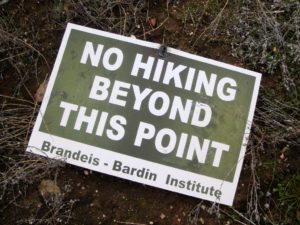
While most of Area IV drains through the Southern Buffer Zone and Bell Canyon into the Los Angeles River, significant parts of it drain into Brandeis-Bardin down into the Arroyo Simi and groundwater which is used as blended drinking well water in eastern Simi Valley mixed with imported supplies. This watershed includes the still radioactively contaminated site of the SRE.
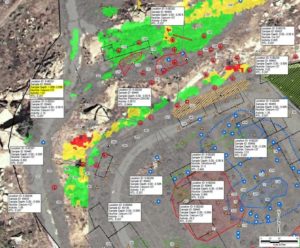
Two reports found elevated cancers and other risks within a few miles of Rocketdyne in 2006. “The new studies were commissioned in 2000 by the state Agency for Toxic Substances and Disease Registry, at a cost of $700,000, after ATSDR had outraged the community by performing a month-long preliminary review the year before and declaring that SSFL chemicals and radiation were harmless to locals,” this reporter wrote in a February 16, 2006 Los Angeles ValleyBeat article called The Fallout.
“The cancer results were nothing less than astonishing,” the article reported. “Hispanics living within two miles of SSFL had 38 percent higher rates of all cancers than Hispanics (and non-Hispanic whites) living over five miles away from the lab and a 252-percent-higher ratio for chemosensitive cancers. Within the same distances and parameters, Hispanics living within two miles of SSFL had 189 percent higher rates of lung cancer, 271 percent more bladder cancer and 430 percent higher rates of melanomas.”
The 2006 UCLA report, Potential for Offsite Exposures Associated with Santa Susana Field Laboratory, showed offsite exposure data in almost every direction from SSFL in air, water and soil. Two radionuclides, Cesium-137 and Plutonium-238, stand out in the UCLA report as being present in above normal amounts in Brandeis-Bardin soil, readings even higher than in the already elevated 2004 Brandeis-Bardin soil tests.
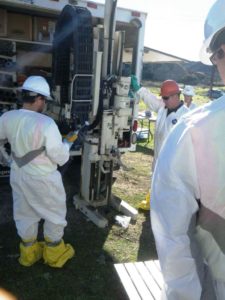
According to documentation obtained by EnviroReporter.com, the California Highway Patrol considers any material or situation over three times background to be the triggering level for a hazardous materials incident. The highest Pu-238 soil reading at Brandeis-Bardin was over 3 times CHP’s HazMat trigger yet Boeing in 2008 explained away these worrisome readings saying a Rocketdyne test again in 1995 found, mysteriously, nothing. “The 1994 study results therefore do not confirm 1992 study results and plutonium-238 is therefore not a concern.”
Perchlorate has been found in 18 wells in Simi Valley, as noted in this reporter’s 2002 exposé Rocketdyne Ranch, which helped lead to the creation of the Upper Las Virgenes Open Space Preserve instead of a massive housing development due to groundwater perchlorate concerns. The preserve, formerly known as Ahmanson Ranch, also borders Area IV and the Southern Buffer Zone on the other side of the lab from Brandeis-Bardin.
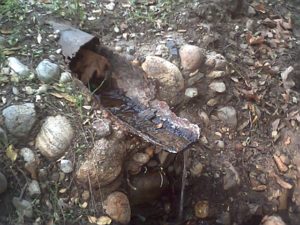
Perchlorate is considered a “precursor chemical” in groundwater meaning it moves faster from its source than other toxic contaminants. Brandeis-Bardin is much closer to the source, SSFL being the most obvious candidate, than the 18 Simi Valley wells that have tested positive. In 2003’s The Sins of Rocketdyne, this reporter noted that Rocketdyne/Boeing official Steve Lafflam had claimed that the perchlorate in Simi Valley wells could have come from road flares or fireworks.
Actually, almost all of the perchlorate contamination nationwide comes from rocket fuel. The solid rocket fuel booster was used in massive quantities at SSFL. Boeing admits that more than a ton of perchlorate was burned in open pits at SSFL to dispose of it. Perchlorate has been found in about a quarter to a third of monitoring wells in Simi Valley, and the two biggest supply wells.
As EnviroReporter.com would later find out in the course of this long investigation, perchlorate has been detected dozens of times at Brandeis-Bardin. Indeed, it was just one toxin in a chemical kaleidoscope that would only be pieced together years later.
Chump Change
Whatever reservations Dr. Bardin had about “Rocketdyne pollution” fouling the camp’s water in 1957 seemed to have evaporated by 1964 when the Brandeis Mutual Water Company was established. Perhaps James Arness didn’t tell Bardin about his cattle dropping dead, possibly from drinking contaminated water in the early 1960s, when he donated the land to Bardin’s Jewish institution a decade later.
By the mid-1990s, after around 15,000 alumni had stayed at the camp recreating in its intermittent streams and exploring its dusty trails, Brandeis-Bardin knew it had a serious problem. The Los Angeles Times broke the news with a December 15, 1995 story called Institute Sues Rocketdyne Over Toxics. In the piece, institute lawyer Helen Zukin tries to walk a fine line on the use of groundwater on the property:
“They cannot and are not using the ground water,” said Brandeis’ lawyer, Helen E. Zukin, alleging that enough toxic solvent has leaked across the property line to render the ground water undrinkable. The institute, however, has never used the ground water, she said.”
The institute seemed to have Rocketdyne dead to rights. “In or about August, 1991 defendants, and each of them, caused plaintiff’s soil and groundwater to be tested in order to determine if plaintiff’s property was also contaminated,” the lawsuit read in documents unearthed by KNBC. “On or about September 3, 1991, initial results of said testing revealed that plaintiff’s groundwater was contaminated. Before this date plaintiff did not know nor could have reasonably known of any potential contamination of plaintiff’s property.”
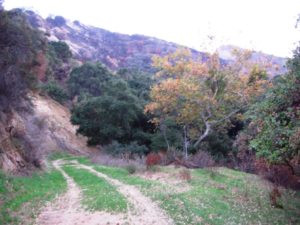
Yet even with its solid case against Rocketdyne, Brandeis-Bardin settled with new lab owner Boeing in 1997 for a net of around $1,862,817.25 after selling its 180 acres of tainted land on SSFL’s northern border with the camp, now known as SSFL’s “Northern Buffer Zone.” It is not known whether or not Brandeis-Bardin gave up any future right to sue over contamination, demand SSFL cease releases onto its property, or to force the polluter to clean up any contamination, past, present or future. It seems unlikely that Boeing would have made the deal if it would remain liable for new toxin finds such as the ones found in this investigation. Neither party has commented on the confidential settlement.
Read more at BRANDEIS-BARDIN’S TOXIC DENIAL INVESTIGATION
Photos, videos, reports, figures, tests, data and special analysis
For years, this reporter and others in mainstream and alternative print media on the SSFL beat were under the impression that Brandeis-Bardin took Rocketdyne/Boeing for at least $30 million. We were wrong. Not only did Brandeis-Bardin settle for chump change, it may have given away any say in further contamination of its land by SSFL. Today, the lab is years and hundreds of millions of dollars away from the only remediation that will prevent more pollution from continuing to plague downhill lands around the lab, a cleanup to background.
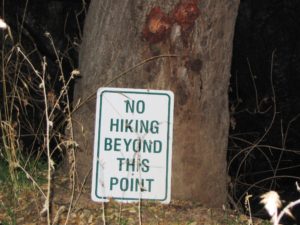
Instead, Brandeis-Bardin has endeavored to paint the place as radiation and chemical free from SSFL even though no major cleanup at SSFL has occurred. For that unlikely scenario to be true, contamination at the top of the hill would have had to somehow magically stayed in place. Newly reported test findings verified and confirmed by EnviroReporter.com, along with those by DOE, and NASA as detailed in this exposé, clearly indicate that is not the case.
Preemptive Strike
Brandeis-Bardin’s efforts to declare its property clean included an unsolicited September 28, 2007 email from a camp director to EnviroReporter.com. Apparently, our reporting on Runkle Canyon had hit a little too close to camp and prompted a series of ‘prebuttals’ from Dr. Gabe Goldman, self-described “Director of Experiential Education” at Brandeis-Bardin.
“My name is Gabe Goldman and I was hired in 2005 by the Brandeis Bardin Institute in Simi Valley to start a new Jewish environmental education program,” Goldman wrote to our general contact address. “As you know, our property lies directly beneath the cliffs of the former Rocketdyne disaster. Before moving here in 2005 from the East, I required that the Institute conduct a study of possible environmental pollution on the land. The Institute agreed and also showed me where it keeps the environmental testing records it has since the late 1980s when it began yearly testing.”
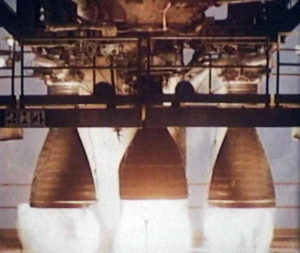
What Goldman failed to mention was that in the May 15, 2006 memorandum from camp radiation physicist Joel I. Cehn to an unidentified, presumably Brandeis-Bardin, official was that perchlorate in any food substance at any level produced at the camp was cause for alarm. Perchlorate damages the human thyroid causing developmental damage especially in infants and children that will manifest oft-times in intelligence loss and impaired organ development. Pregnant women are especially vulnerable to perchlorate’s toxic punch.
California’s limit for perchlorate in drinking water is 6 parts per billion, or ppb. The memorandum, courtesy of a limited number of documents that AJU gave to the KNBCI-Team, said that a whopping 14.9 ppb of perchlorate was in its 2004 milk, over double the state limit. The scant report doesn’t say what the camp did with its milk.
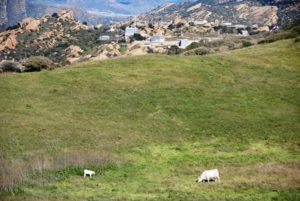
Goldman’s 2007 email to EnviroReporter.com continued:
“Runkle Canyon borders on the southwest side of our property and I’ve been reading your information about what you’re finding there. I don’t doubt what you’re finding but wonder why we haven’t found anything here.”
Actually, as this article amply shows, plenty had been revealed about the radiation and chemicals in Brandeis-Bardin before Goldman’s 2007 missive. His reasoning resembles some of the rhetoric years later that has been leveled against KNBC for its sin of even reporting about Brandeis-Bardin’s radiation and chemical issues.
Nuclear Reactions
Unknown to EnviroReporter.com as it investigated, prepared and produced this investigation, KNBC – Channel 4’s I-Team would come out with Brandeis-Bardin coverage that produced new information. Along with shaking loose radiation and chemical testing data, KNBC precipitated reactions from American Jewish University, former Brandeis-Bardin employees like Gabe Goldman, and individuals who attended Camp Alonim over the decades.
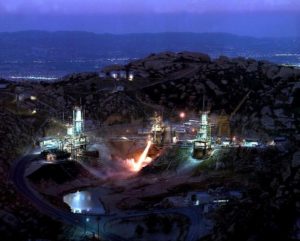
Ruminations, heartbreak and betrayal marked some of the comments. “The attacks on [KNBC‘s] Joel Grover a well respected journalist as well as former employees who are well respected members of our community are just so wrong,” commented Leslie Sackheim the next day on the forum. “I had a beautiful niece who attended many retreats at Alonim during her childhood. We lost her a few years ago after a year long ugly battle with non-smokers lung cancer. She was in her twenties and was suppose[d] to be married the same month she passed. Watching her suffer was horrific and heartbreaking. I can’t stop asking if her illness and time at Alonim were related?”
Read more at BRANDEIS-BARDIN’S TOXIC DENIAL INVESTIGATION
Photos, videos, reports, figures, tests, data and special analysis
David Dassa, a forty-year self-described “role model to countless children and young adults who have spent time at Camp Alonim,” shared with the forum an email he sent November 12, 2015 to Robert Wexler, president of AJU. Dassa had been interviewed by KNBC for its investigation and had been criticized for it by some in the Jewish community.
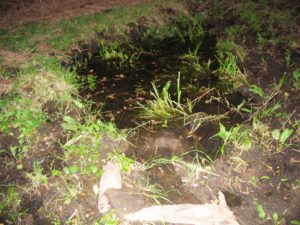
Dassa was also amazed by the trove of previously secret documents detailing Brandeis-Bardin’s financial settlement of the contamination of its land in the mid-1990s. “Now, as the confidential settlement agreement with respect to the lawsuit has been made public, I see that my worst fears have been confirmed,” Dassa wrote to Wexler. “It is hard to fathom how, on the eve of trial for a matter of this magnitude (where who knows how many thousands of lives were and may continue to be put at risk), that Brandeis settled the case for a mere $3.2M, with 35% of that amount paid to Helen Zukin and an outside law firm (noting that both Helen and the outside law firm each “kindly” donated $35K of their fees back to the institute).”
Closing with an appeal to Jewish decency, Dassa spelled out what he felt needed to be done by AJU. ”It is extremely unprofessional, divisive, and very sad that the AJU and you personally have chosen to discredit me and other leaders in the Jewish community,” Dassa wrote. “This constitutes Lashon Hara [“evil tongue“], rather than Tikkun Olam [“repair of the world“]. I believe that only with an apology and full disclosure by the AJU of any and all soil and ground reports, will Brandeis-Bardin be able to perhaps move forward.”
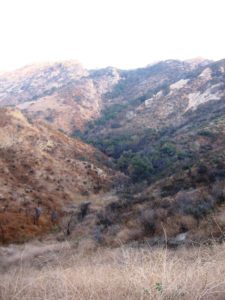
American Jewish University wasn’t done with KNBC either. “This latest story from KNBC continues to create gross misperceptions about the Brandeis-Bardin property and more than two decades of environmental test results that affirm the property is safe,” said Wexler in a Nov. 21, 2015 letter to the “Alonim Family.”
“Earlier this month, the DTSC confirmed the safety of the Brandeis site at a public workshop. And as recently as October 15, 2015, the DTSC wrote: “Based on available data, there is no evidence of contamination from SSFL [the Santa Susana Field Laboratory] that poses an off-site threat to human health or the environment.” This is very clear-no threat to human health or the environment extending beyond SSFL. This statement can only be understood to refer to the entire 2,700-acre Brandeis-Bardin property.” [Wexler emphasis]
In another bullet point, Wexler wrote “In 1995, the EPA determined there were low levels of contamination in remote areas of what was then Brandeis-Bardin property, but declared: “…the theoretical cancer probability or risk to campers and camp counselors is less than the EPA’s.” [Wexler emphasis]
In May 2016, AJU claimed that new “extensive” testing it commissioned proved that there was no “unacceptable” risk to public health on its property. But an NBC4 investigation revealed numerous problems. Experts including Bob Alvarez, former senior adviser to the United States Secretary of Energy, and Dan Hirsch, director of the Program on Environmental and Nuclear Policy at UC Santa Cruz, criticized the study for taking too few samples.
Read more at BRANDEIS-BARDIN’S TOXIC DENIAL INVESTIGATION
Photos, videos, reports, figures, tests, data and special analysis
The study took only 14 samples out of Brandeis’ 2,878 acres. Even so, according to Hirsch, one of those 14 samples found Strontium-90 at two and half times local background. Critics of the study also noted that it did not test for many chemicals known to be on the SSFL property. AJU also claimed that the US EPA had found the site safe – claims denied by EPA when asked by the KNBC I-Team.
The lab that AJU chose to conduct the study, Tetra Tech, was recently fined $7,000 by the Nuclear Regulatory Commission for deliberately falsifying soil samples from another former nuclear site in San Francisco. Even so, by simply agreeing to “Discuss the facts and lessons learned from this event with its employees who are engaged in licensed activities within 180 days, emphasizing the importance of not engaging in willful activities in violation of NRC’s regulations,” Tetra Tech avoided the fine.
This time, AJU lashed out at KNBC before the segment even aired, sending KNBC a letter stating that, “We remain concerned that the piece you plan on airing tonight might defame BBC by implying that wrongful conduct has been perpetrated by AJU or that the safety of our campers or visitors to our campus has in some manner been compromised.”
“Fission Products” and “Reactor Control Rods”
Typically the most damning contamination findings come in dense scientific reports that require a keen eye to find data related to Brandeis-Bardin if, that is, it exists at all. Another such report arrived January 20, 2016. The 239 page study [36.98 MB] for the Department of Energy was called “Department of Energy (DOE) RCRA Facility Investigation Groundwater Work Plan Portions of Area IV under DOE Responsibility.”
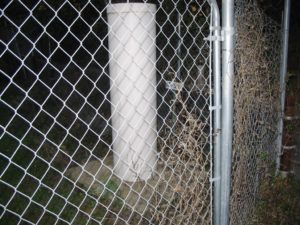
They also result in some extraordinary readings. RD-59A, monitored from 1989 to 2011, had a high for radioactive tritium with a reading of 110 picocuries per liter (pCi/L). “No SSFL operations occurred off-site,” read the report before making an incredible leap of logic. “Tritium detection frequency and activity confirm that there are no tritium off-site sources. No future action is required for off-site wells.”
Later in the report, RD-59A is recorded as having a filtered reading of Cadmium-113m of 9,700 pCi/L. The well is subsequently recommended for future sampling because “Cadmium-113m neutron activation of Cadmium-112 used in reactor control rods – possibly site process related.” [Report emphasis] Presumably, “site process related” means that it came from SSFL activities.
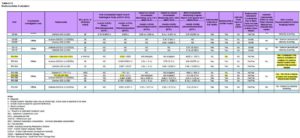
Nothing says radioactive contamination more than finding a “possibly site process related” isotope directly related to nuclear reactors downhill from Area IV of the Santa Susana Field Laboratory. Yet nothing is what AJU has had to say about it. Either Brandeis-Bardin representatives had no clue of the findings or they did know these astonishing results and chose not to share them.
Neither explanation can account for the institution’s howling of certainty that its property has not been impacted by SSFL by one iota. The information kept on coming, courtesy of the department supposedly in charge of the Rocketdyne cleanup, a government agency also apparently blind to the data that the DOE created.
New Toxic Fluoride Levels in Brandeis-Bardin Groundwater
DTSC sent EnviroReporter.com an email “DTSC-SSFL Document Upload Notification: SSFL NASA Area I LOX and Area II Groundwater Monitoring Report Third Quarter 2016” with a link to the report [1,180 PDF pages; 17.3 MB] November 30, 2016. “Monitoring wells RD-68A and RD-68B and seep well SP-29B are the only wells located offsite that were sampled during the third quarter 2016,” the report says of these wells which are on Brandeis-Bardin property. “Fluoride was detected above the SSFL comparison level of 0.8 mg/L [milligrams per liter] at RD-68B and SP-29B at concentrations of 0.97 mg/L and 4.8 mg/L, respectively.”
While fluoride might seem an innocuous chemical added to drinking water to fight cavities, or a threat to “precious bodily fluids” as comically suggested in Dr. Strangelove, it is hazardous at high levels.
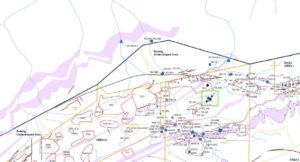
“Samples collected from SP-29B were submitted for radionuclide analysis during third quarter 2016,” the NASA report added. “Nine individual radionuclides were detected, for which there are screening criteria for only five of these analytes (gross alpha, gross beta, gross beta-decanted, uranium-233/234, and uranium-238).” Actual levels of the radiation weren’t provided. The report also didn’t list exactly what the other four radionuclides were or their amounts either.
Fluoride might seem an odd chemical to find at such high levels in Brandeis-Bardin gurgling out of its artesian water. Yet according to an April 14, 1983 Rockwell International memo obtained by EnviroReporter.com entitled “LETF Fluoride Incident, 3 March through 31 March 1983,” contaminated water from the Bowl Area [R-1] and Perimeter Pond reservoirs at SSFL was sprayed on the surrounding area dirt to bring down the levels of fluoride.
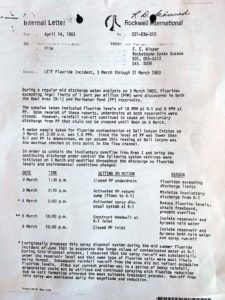
According to the US National Council on Research, toxic concentrations of fluoride in drinking water can lead to weakened bones and cause hip and wrist fractures. In Fluoride in Drinking Water: A Scientific Review of EPA’s Standards (2006), the council said fractures occur at fluoride levels of 1 to 4 mg/L. Brandeis-Bardin’s artesian levels of fluoride were found in excess of this in samples pulled twice in 2016. The hazards of fluoride at high levels has been known for decades. Clinically-significant renal dysfunction is possible with fluoride drinking water levels of 1 ppm according to “Metabolism and renal effect of enflurane in men” in the journal Anesthesiology in 1976.
AJU Jolts Jewish Journal
New information was provided December 7, 2016 by the Jewish Journal when it published a piece saying that some of Brandeis-Bardin’s soil was going to be remediated by the Department of Energy. The DOE had found toxins at levels above background on camp property and were considering removal of the dirty dirt according to the story.
Jewish Journal had learned of the plan from part of a DTSC draft environmental impact report on the upcoming remediation of Area IV given to it by Santa Monica-based Consumer Watchdog. Accompanying the news article was correspondence between AJU and the paper, as well as an undated DOE list of contaminants it found in Brandeis-Bardin.
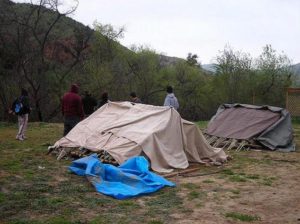
“In short, the samples show a soil profile that is not meaningfully different from what you would find if you sampled the average American front lawn,” Strear wrote. “Since DTSC has stated explicitly that there is no risk to human health in these sample results or in any other data collected from BBC to date, it is difficult for me to understand how an article about a project description included in a preliminary administrative draft EIR [Environmental Impact Report] would provide any meaningful information to your readership. On the contrary, it could well serve to give further unfounded cause for concern.”
Strear may have not known that the significance of the data he included with his missive to Jewish Journal. It had a list of Brandeis-Bardin contaminants found above Area IV background levels with their exact Brandeis-Bardin measurements. Assuming the veracity of the document, the DOE was likely investigating contamination pathways as part of its AOC-related investigation into the extent of its toxins in soil. DOE representatives have stated publicly that if Area IV contamination was found offsite, it would clean it up. It seems the draft EIR indicates it will do just that which would be good news if AJU welcomed it and the resultant cleanup. Plus, it would cost the camp nothing.
Read more at BRANDEIS-BARDIN’S TOXIC DENIAL INVESTIGATION
Photos, videos, reports, figures, tests, data and special analysis
NASA has an identical AOC with DTSC. Both AOCs include soil and groundwater. Any contamination emanating from SSFL down drainages adjacent the site is supposed to remediated as well hence why the DOE followed the contamination down into Brandeis-Bardin when it made its discoveries. All of the excess radiation and chemicals have to go if the cleanup is to be complete and leave such offsite locations safe for future generations.
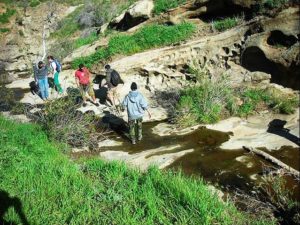
That the Jewish Journal would publish a summary that makes the unlikely assertion that none of the chemicals tested high are related to Area IV with no analysis would seem puzzling were it not for another strange turn of events when the article was published. The title of the piece, “Remote Brandeis-Bardin area may need cleanup,” was amended within hours of going on the Jewish Journal website to “Remote Brandeis-Bardin area may need cleanup, no health threat seen.” Then the headline went under a third revision with “Remote Brandeis-Bardin area may need cleanup, state officials see no health threat.”
No explanation was given for the addition of “no health threat seen” and then that the state doesn’t see one either. Yet it was, literally, correct. DTSC has always said there is no health threat so it doesn’t ‘see it.’ Jewish Journal didn’t see a health threat either because it apparently didn’t analyze DOE’s numbers. If it had, it would have found what EnviroReporter.com did by simply cross-checking them with their publicly available BTVs.
Tolling the Toxins
The DOE’s sampling test results in Brandeis-Bardin are stunning. No less than 22 chemicals are higher than their SSFL background readings requiring a comprehensive EnviroReporter.com analysis of Brandeis-Bardin contamination found by DOE. That examination is called 2016 DOE-AJU Summary Brandeis-Bardin Soils.
Among the standouts, the heavy metal antimony registered three times its Area IV BTV in Brandeis-Bardin. Found in at least 403 of 1,416 of the EPA’s National Priorities List of hazardous waste sites nationwide, antimony can be dangerous. “In long-term studies, animals that breathed very low levels of antimony had eye irritation, hair loss, lung damage, and heart problems,” according to ATSDR.
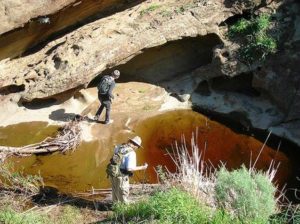
“People may be exposed to higher-than-normal levels of selenium at hazardous waste sites by swallowing soil or water, or by breathing dust,” says ATSDR. “The way that selenium can enter the body from a particular site depends on such factors as whether vegetables are grown in soil in which selenium from the site has been deposited, whether water at the site contains selenium and is able to flow into drinking water supplies, and whether selenium dust blows into the air.”
Several PAHs were detected above their BTVs in Brandeis-Bardin drainages down into the camp as well. “People living near waste sites containing PAHs may be exposed through contact with contaminated air, water, and soil,” reports ATSDR. “Studies of people show that individuals exposed by breathing or skin contact for long periods to mixtures that contain PAHs and other compounds can also develop cancer.”
The PAH naphthalene registered a substantial 5.4 times its SSFL BTV. “Naphthalene has caused cancer in animals,” according to ATSDR. “Naphthalene can become weakly attached to soil or pass through soil into underground water.”
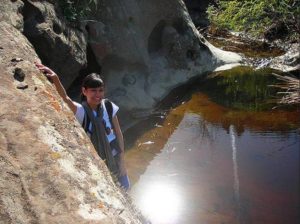
The PAH fluorine was detected at 5.7 times its BTV. It is described by the CDC as a “Pale-yellow to greenish gas with a pungent, irritating odor,” and is listed under “Immediately Dangerous to Life or Health Concentrations (IDLH).” Used as a chemical intermediate in a wide range of industrial uses, fluorine is sourced to formulate polyradicals for resins.
A wide range of herbicides and pesticides were used at Rocketdyne, many more than you would find on a typical lawn. That explains why the Area IV chemical background study identified so many and determined their BTVs. It might also explain how so much of these poisons ended up being detected by the short DOE report given by AJU to Jewish Journal then made public and analyzed by EnviroReporter.com. No less than a dozen of these substances exceeded their Area IV BTVs.
The insecticide Endosulfan I in Brandeis-Bardin measured a considerable 8.6 times its BTV. “How might I be exposed to endosulfan?” asks ATSDR in its ToxFAQs for Endosulfan page. “Touching contaminated soil or fruits or plants that have been sprayed with endosulfan will result in a small amount entering the body through the skin.”
Dieldrin is an insecticide that was banned for all uses by the EPA in 1987 yet is still found in Brandeis-Bardin dirt tested by the DOE at 3.1 times its background threshold value. “[D]ieldrin build up in the body after years of exposure and can affect the nervous system,” says ATSDR. “In animals, oral exposure to lower levels for a long period also affected the liver and decreased their ability to fight infections. We do not know whether aldrin or dieldrin affect the ability of people to fight disease.”
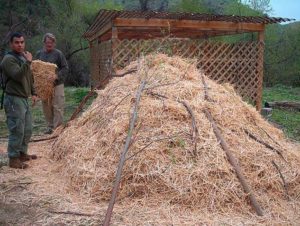
What is relevant to humans, at least the ones visiting, working, camping and living at Brandeis-Bardin is that Rabbi Strear and American Jewish University had already claimed “that there is no risk to human health in these sample results or in any other data collected from BBC to date.” Results from decades ago all the way through December 2016 from EPA, DOE, NASA and EnviroReporter.com may speak a very different story. Regardless of all these data showing toxic problems oozing from SSFL, the Obama Administration’s Department of Energy parting shot made clear in the first week of 2017 that it didn’t want any cleanup of Area IV at all.
Pollution Solution
DOE’s public policy line was different three years prior. “Let’s clean up to background,” said John Jones, federal project director for the DOE in Area IV, before a meeting of the SSFL Workgroup February 5, 2014. Jones told the audience that the agency was committed to the AOC it signed because, quoting another DOE official, “At the end of the day…it’s the right thing to do.”
Read more at BRANDEIS-BARDIN’S TOXIC DENIAL INVESTIGATION
Photos, videos, reports, figures, tests, data and special analysis
Jones’ words were well received. Indeed over 3,700 public comments had been submitted in support of the AOC with only a handful opposed. Soon after, Jones wasn’t so vocal. KNBC‘s Joel Grover filmed Jones refusing to speak with him at an SSFL-related meeting in 2015.
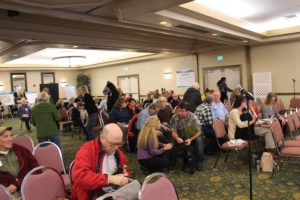
There is analysis of three options for cleanup that drastically allow more radiation and chemicals than DOE’s AOC allows. The first option would leave up to 39 percent of dirty dirt in place, the second allowing 91 percent of the soil not cleaned up and the third possibility leaves up to an amazing 99 percent of the known contaminated land not remediated.
Community outrage was evident February 18 when the DOE held the first of two public meetings to take public comment. “You promised six years ago you would clean up the mess you made so that it would be like you never made it in the first place,” said Devyn Gortner of Teens Against Toxins at DOE’s meeting in Simi Valley. “The community has debunked every single one of your excuses as to why you cannot keep this promise.”
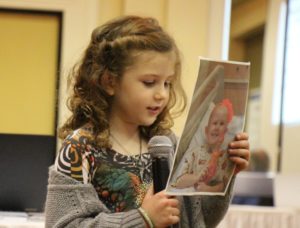
“My daughter was diagnosed, recently, with leukemia, a rare form called APL, which the doctors said it was directly related to an environmental issue,” said West Hills resident Mark Dow before the DOE panel in Simi Valley which included John Jones. A husband and father of two, Dow has lived about a mile from SSFL since 1996. “Our neighborhood has also had other cancers. We’ve had two children with brain cancer. We’ve had an adult die from brain cancer. We’ve also had two other cancers within our block. So when people say there is no direct correlation [to SSFL], I have to object.”
“We were there when the fires burned [2005] at that site and I could see the ashes coming into my yard and they looked extremely strange,” Dow continued. “They weren’t typical ashes and you could see it was muddy, gluey, particles coming into our neighborhood and it was appalling.”
Though much fewer in number, people against full cleanup of SSFL spoke out too. One was Nancy Kidd, an archaeologist who said at a DTSC meeting in 2013 that excavating “any dirt” at SSFL would result in Valley Fever region-wide. Kidd’s choice of words and their emphasis, repeated here in their entirety, shocked some in the crowd who knew their Holocaust history.
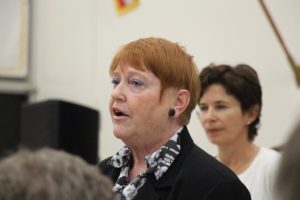
The crowd gasped at the hopefully inadvertent use of a term more appropriate to a Nazi like SS-Sturmbannführer (Major) Wernher von Braun back when he was an Adolf Hitler favorite. As outrageous as Kidd may have sounded, DOE’s conclusion that all this fuss about radiation and chemicals is specious may sound even worse. The department makes it abundantly clear that it doesn’t think there is anything to worry about, sound science be damned.
“Because there is little difference between those risks, there would also be little difference between the risks following cleanup under any of the soil remediation alternatives—risks in all cases would be close to those from exposure to background soil,” the DOE report reads suggesting there’s no need for any cleanup at all.
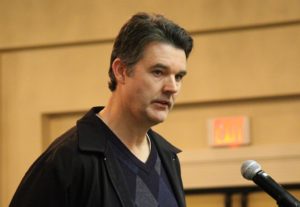
Not only does DOE boldly blind itself to all the foulness EPA found and figured the background levels for, it seems equally unable to comprehend that the department cannot unilaterally nix the cleanup. The AOC it signed in 2010 to clean up to background radiation and chemicals is a legally binding document. The AOCs for both the DOE and NASA make it explicitly clear that DTSC will determine cleanup decisions for both chemicals and radiation in the SSFL cleanup.
While the DOE states at the beginning of the draft EIS report that “DOE has no preferred alternative at this time,” it’s clear that the department does have a preference, and that is doing as little cleanup as possible. “The negative incremental risks calculated for the No Action Alternative imply that the concentrations of chemical and radionuclides in soil from site-related activities are less than the variability of background concentrations of those chemicals and radionuclides. Therefore, the risk of cancer incidence or death from chemicals and/or radionuclides in Area IV and the NBZ are comparable to or less than the risk determined for background soils.”
It goes without saying that if the DOE manages to get marching orders to do nothing in Area IV and the NBZ, nothing they will do. That leaves any possible contamination at Brandeis-Bardin, and its obvious source, left there forever. Nothing would please the polluters and their like-minded pals in the Trump Administration more.
The prospect of eternal pollution being the solution did not please the Ventura County Board of Supervisors in whose county the lab sits. At a March 7 meeting, the board made their unhappiness with the DOE clear with a 4-0 vote demanding adherence to the AOC. “Unfortunately, the EIS does not analyze cleaning the DOE site to the agreed upon stipulations in the 2010 Agreement on Consent,” the board’s letter to the DOE states. “Instead, hundreds of thousands of cubic yards of soil, some with known significant chemical and radiological contamination that would be covered by the AOC, are exempted from remediation.”
Read more at BRANDEIS-BARDIN’S TOXIC DENIAL INVESTIGATION
Photos, videos, reports, figures, tests, data and special analysis
“They have not done an analysis of cleaning up to background,” Supervisor Linda Parks said of the DOE at the board meeting, “something that they have a legal binding agreement to do so. If you look at the document, they have excluded somewhere in the neighborhood of 300,000 cubic feet to half a million cubic feet of soil from even the consideration of remediation.” Supervisor Steve Bennett concurred adding, “[T]his backsliding after all of this work and all of these agreements … is not appropriate or good government policy in terms of following through on commitments.”
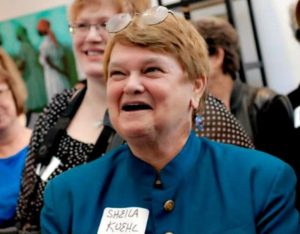
“This site has been a little unusual, actually, even compared to our other toxic sites in the county, because the federal government is so implicit in keeping this a dirty site and keeping it from being cleaned up, in not just dragging their heels, but in creating documents that lowball the danger, that lowball the health effects,” Kuehl declared to a room packed with appreciative pro-cleanup supporters. “Well, I believe in a cancer cluster when I see one, and I know what’s going on in these neighborhoods and what has been. If you see the film that was made about this site, and you see the workers given plastic aprons to go in and clean up a nuclear meltdown, or you see them shooting rifles at barrels of radioactive materials to set them on fire, and you watch this radiated material rising up into the air and spreading over miles of this area, and you think, well, you know, in the old days, they would claim, ‘Oh we didn’t know what we were doing, or we did and we didn’t care.’ But to say in the 21st Century ‘we know and we don’t care’ is really inexcusable.”
Toxic Test Stands
Then an anti-cleanup bolt out of the goo struck that would effectively relieve NASA of the majority its huge cleanup burden in its areas of responsibility at SSFL. Republican congressman Steve Knight (CA-25) sent a bipartisan letter to the acting head of NASA March 21 asking for the remaining rocket test stands at Rocketdyne not be demolished because of their “historical significance.”
“We understand the need to complete the cleanup of toxic chemicals in the area from the many years of research and testing. However, the environmental protection mission and the preservation of such an important piece of our shared history are not mutually exclusive goals,” Knight and his co-signers stated in the letter. “It would be a tragedy to lose these test stands and deny future generations the ability to connect with this history and humanity’s ongoing search for a better understanding of our universe.”
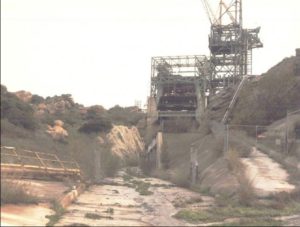
Despite highfalutin rhetoric to the contrary, leaving the test stands in place means leaving the pollution which would make any chance of eventually cleaning up Brandeis-Bardin virtually impossible. The proposal conveniently also leaves out how to pay for restoring the test stands which are covered in peeling lead paint, according to NASA, as well as how to secure and insure them since the public would presumably be in their proximity. Nowhere does Knight suggest where the substantial funds needed for what could be called Glow in the Dark Park would come from.
What is also left out of the anti-EPA arch conservative congressman’s flowery pitch is any mention of the Nazi origins of SSFL or its impacts environmentally on the surrounding communities including the large Jewish camp downhill from contaminated NASA land and groundwater. This isn’t surprising coming from Knight who is against federal regulation of greenhouse gas emissions and who voted with just two other California legislators to allow the display and sale of Confederate flag images in California state museums and gift shops in 2014.
Read more at BRANDEIS-BARDIN’S TOXIC DENIAL INVESTIGATION
Photos, videos, reports, figures, tests, data and special analysis
What is surprising is that he got a handful of congress members who have previously supported the cleanup to co-sign the letter. Most dismaying to cleanup advocates is Congresswoman Julia Brownley (CA-26) signing on to Knight’s letter even though she has long advocated for the full cleanup of SSFL to background.
On a historic level, the dilapidated SSFL test sites do not rank with the many test stands at Cape Canaveral, Florida, where this reporter lived as a child growing up to love their grandeur and significance to space exploration. Indeed, the most historically noteworthy SSFL rocket test stands, the V-2 rocket ones brought to the new lab after World War II in Nazi swastika-emblazoned boxes and reassembled, have already been removed.
Toxic Denial
A re-imagining of SSFL’s toxic past and present took place March 29 at a meeting of the DOE-funded SSFL Community Advisory Group (CAG), a group exposed as a ‘greenwashing’ and ‘astroturf’ front in 2012 in Greenwashing Rocketdyne. The sparsely attended meeting took place at the Shomrei Torah Synagogue in West Hills.
The DOE is actively working against its own AOC agreement to clean up Area IV and its environs to background as first revealed in Dept. of Energy secretly funding front group to sabotage its own Santa Susana Field Lab cleanup in September 2016. That front group is the CAG, a DTSC-approved attempted replacement of the SSFL Work Group against the majority of the extensive community’s wishes.
One of the 18 people in the audience in a room seating over 150 was CAG Member Ross Berman, a former employee of SSFL contractors CH2M Hill and Tetra Tech, who was handing out packets of information. Another was William Preston Bowling who taped and took photographs of the public event that he shared with EnviroReporter.com.

“Is that the rabbi [Rabbi Jay Strear] from Brandeis?” Bowling wrote in an e-mail to EnviroReporter.com during the event. “I say it is. Maybe he dropped off the Brandeis document or asked the CAG to pass it out.”
The four pager purportedly from AJU is called “Fact Sheet – Brandeis-Bardin and the Santa Susana Field Laboratory” and makes the strongest claims yet that there has been no impact at all to its property from SSFL. Some of the claims, however, don’t seem rooted in the actual facts. This is ironic because in its zeal to discredit and intimidate TV reporter Joel Grover, AJU tried to pull scientific rank on the longtime award-winning investigative journalist.
“Mr. Grover¹s so-called investigation is an undifferentiated ³the sky is falling² tale – the kind of spectacular story intended to draw attention with little attention to actual facts,” wrote AJU’s communications and marketing VP Joanna Gerber May 4, 2016. “The complex nature of the scientific findings appears to have eluded your writers and your editors.”
Perhaps it has eluded AJU that its “fact sheet” handed out at the CAG meeting made claims that are not supported by the facts. In fact, the evidence comes from the fact sheet itself.
“Environmental conditions on the Brandeis Bardin Campus have been studied extensively since 1991 by federal and state environmental agencies, as well as independent third-party engineers,” the AJU fact sheet states. “During that time, hundreds of soil, sediment, surface water, groundwater, and vegetation samples taken from the BBC have been analyzed. In 2016, an additional test – known as a gamma survey-was conducted on the main camp area and in the southern ravines. At no point in time have these tests shown any evidence of contaminant migration from SSFL.”
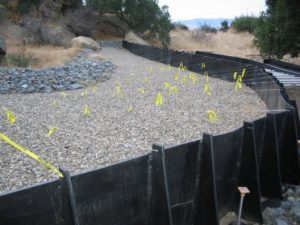
Yet AJU’s fact sheet claims that from 1991 on, there has been no evidence that SSFL goo got onto its property. If this AJU statement were true, wouldn’t it mean that the action Brandeis-Bardin brought against Rockwell in 1995 and settled with Boeing in 1997 confidentially for $3.2 million shouldn’t have happened? If there was no contamination, why did Brandeis-Bardin sue over it? Why did Boeing pay Brandeis-Bardin millions to settle?
AJU has made no typo here as this claim is repeated. “In 1991, a rigorous testing program began at BBI to determine whether contamination at the SSFL had migrated to the BBI property,” says the fact sheet. “The results of those tests consistently show no migration from SSFL to the Brandeis Bardin property.”
Read more at BRANDEIS-BARDIN’S TOXIC DENIAL INVESTIGATION
Photos, videos, reports, figures, tests, data and special analysis
The claim is repeated yet again this time citing AJU’s Tetra Tech report. “Tetra Tech found no evidence of contaminant migration from the SSFL,” reads the AJU fact sheet. Indeed, AJU’s shaky claims flow into leaky descriptions of how there is no way SSFL’s toxins can even get to Brandeis-Bardin property.
“Since 2010, storm water runoff from SSFL is primarily diverted away from Brandeis Bardin,” the paper claims. “Storm water diversions have been constructed on the SSFL to prevent the flow of runoff from the SSFL on or toward the BBC.”
“It’s not diverted away, yet in places they [Boeing and/or its subcontractors] have created bioswales to hold storm water runoff in place from Area I in the northern drainage, and there are some BMP [“Best Management Practice”] work before and after the outfalls in Area IV that connect to AJU,” said Bowling in an email after the CAG meeting. “The camp has been dealing with Rocket-Goo since the 1940s as per the letters produced in the NBC expose.”
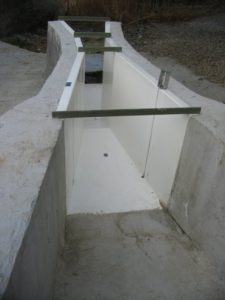
But that’s about it even though AJU claims otherwise. “What is released onto BBC is first processed to drinking water standards.”
If the water flowing off of Area IV met drinking water standards, why would AJU feel compelled to have maintained signs in Meier Canyon that said “WARNING DO NOT DRINK OR USE THIS WATER”? And why would AJU’s fact sheet make the conclusion that “Decades of testing have shown no evidence of contaminant migration from SSFL to BBC”?
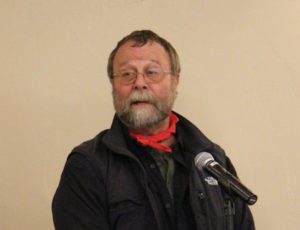
That’s because the question hasn’t been asked because it is senseless and Luker knows it. The former Venice Beach juggler has repeatedly tossed out these cock-and-bull stories since he first started collaborating on the scheme to greenwash SSFL with former Los Angeles Times reporter and Boeing hired gun Gary Polakovic as exposed in Boeing’s Meltdown Makeover in 2012.
Bonnie Klea, long renowned as The Atomic Avenger, knows Luker quite well. Klea, recently profiled by the Los Angeles Daily News, has been on the receiving end of his belittling remarks for years. Recently, she was named the 2017 Pioneer Woman of the Year by Los Angeles Councilmember Mitchell Englander for “her exceptional work advocating for those affected by the Santa Susana Field Lab during the partial meltdown of a sodium reactor occurred in 1959 at the site.” [sic]
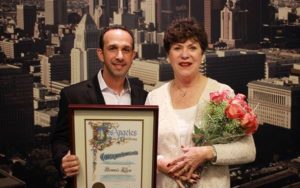
“If there was the remotest chance that there actually is cancer, somebody’s got to start doing some soil testing because the contamination is not at SSFL,” Luker said without the slightest trace of irony. “So we have to start looking at, maybe, school yards, public parks where we could do the testing and sampling and see if there’s anything there.”
Look anywhere but where there is dirt so hot that it is over a thousand times background, DOE’s Area IV sitting high above the Jewish camp. That kind of nonsense might work for people new to the issue but it doesn’t fly with folks who’ve fought for full cleanup of the hot zone for decades.
Now or Never Again
Talking with a DOE official at the February 18 EIS meeting in Simi Valley, this reporter asked that if Area IV contaminants were found in Brandeis-Bardin above background, would DOE remove them per the AOC. DOE’s project manager for Area IV, John Wondolleck, said yes “in terms of anything that migrated from [Area IV]” before a DOE person intervened and offered an on the spot interview with DOE’s John Jones.
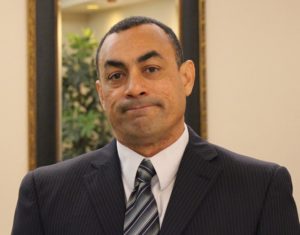
SSFL’s DTSC project manager Mark Malinowski has repeatedly stated that if any contamination was found in Brandeis-Bardin related to Rocketdyne, DTSC would ensure that the responsible parties would be obliged to clean it up to background. In this case, NASA and the DOE would be those parties. These assurances were made last year in DTSC’s April 12, 2016 presentation, and again in its December 22, 2016 letter to state Assemblymember Matt Dababneh (D-Van Nuys), where DTSC director Barbara Lee wrote, “I would like to emphasize that, if contaminants were detected at concentrations that posed an imminent threat to human health or the environment at Brandeis-Bardin Campus, DTSC would have issued an order for an immediate cleanup.”
Considering that there has been no comprehensive examination until this exposé of what the contamination and remediation challenges are, the public now has the knowledge to determine what it wants done at SSFL and Brandeis-Bardin. The public can comment on DOE’s Draft EIS by April 13, 2017.
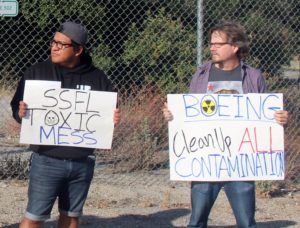
While the sordid history of this place suggests that the worst will indeed continue to pass, the information unearthed here, in over thirteen years of digging, will nevertheless warn the unwary of what secrets lie in and around the Santa Susana Field Laboratory. People that make the Simi Hills their playground, destination or home deserve to know what risks await.
[Last updated 9:20 pm PSDT June 10, 2017]
Read more at BRANDEIS-BARDIN’S TOXIC DENIAL INVESTIGATION
Photos, videos, reports, figures, tests, data and special analysis
25 Years of Award-Winning SSFL/Rocketdyne Reporting
1998 – 2023
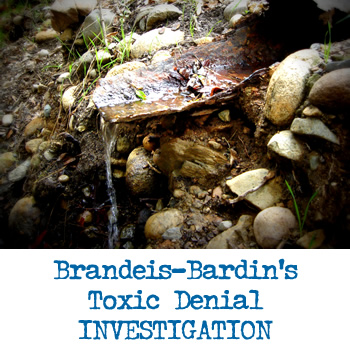












Have there been any reports of children getting cancer who have attended the camp
OPEN LETTER – “Are Jews at Brandeis-Bardin immune to radiation and chemicals?”
[Published on EnviroReporter.com in comments for “Brandeis-Bardin’s Toxic Denial” 2017 exposé at https://www.enviroreporter.com/2017/04/brandeis-bardins-toxic-denial/all/1/]
To: Ms. Rachel Levin, contributor to the New York Times Travel section
via http://byrachellevin.com/
From: Michael Collins, EnviroReporter.com
Regarding: New York Times September 18, 2019 Travel section article “Jewish Summer Camp With Campfires, Crafts and No Lights Out” by Rachel Levin at https://www.nytimes.com/2019/09/18/travel/jewish-adult-summer-camp.html
Ms. Levin,
Your article on the Jewish camp at Brandeis-Bardin in Simi Valley, California, would have been better informed if you had noted that “fission products” and radionuclides “used in reactor control rods” have been found at Brandeis-Bardin according to U.S. Department of Energy (DOE) reports. DOE operated above and bordering the camp at the heavily polluted Santa Susana Field Laboratory (SSFL) which experienced three partial nuclear meltdowns.
Perhaps you should have told your readers that 600 acres of SSFL drain into Brandeis-Bardin where elevated levels of radionuclides have been found in the soil, surface water and subsurface water including Strontium-90, Plutonium-239/240, Uranium-238 and beta radiation.
Your piece might have been more informative, and accurate, if you let your readers know that SSFL owner Boeing paid off Brandeis-Bardin $3.2 million for polluting its land in the late 1990s and bought much of the contaminated border property from the camp to serve as a new “Northern Buffer Zone.”
Jews, and other New York Times readers, might have been better served being informed that SSFL was first started to test Nazi war criminal and SS officer Wernher von Braun’s V-2 war rockets, the production of which cost 20,000 Mittelbau-Dora concentration camp inmates their lives with 9,000 dying from exhaustion alone. About 350 of these Nazi slaves were hanged, including 200 for sabotage, with the remainder shot or dying from disease and starvation.
Our online news organization’s website EnviroReporter.com, KNBC‘s I-Team and Jewish Journal have covered the contamination problems at the camp yet you and the New York Times fail to even allude to them.
A correction at the end of the piece confirms that Brandeis-Bardin’s name was misspelled in the original copy. That suggests that not a lot of fact-checking was done for this feel good travel piece that unfortunately forgot the meltdowns, Nazi rockets and contamination emanating from high above, and bordering the Jewish camp.
Michael Collins
EnviroReporter.com
Interesting new 2018 data in the Northern Buffer Zone that drains into the American Jewish University’s Brandeis-Bardin Campus.
https://www.dtsc-ssfl.com/files/lib_rcra_groundwater/quarterly_an_gw_repo/quarterly/68374_2018_Q3_Groundwater_Level_Monitoring_Report.pdf
Wells RD 33 A and C were found “Tampered With” yet in the polluters technical memorandum they are marked as non-detect.
https://www.dtsc-ssfl.com/files/lib_rcra_groundwater/interimmeasures/correspondence/68375_DOE_GWIM_Status_Tech_Memo_11-10-18.pdf
I guess that’s one way to cancel out “True Findings” or the other way is blatantly saying in the report that they are “False Positives” or “Anomalies” when Radioactivity (Strontium 90) was found in well RD-59 A and C
https://www.dtsc-ssfl.com/files/lib_rcra_groundwater/quarterly_an_gw_repo/quarterly/68374_2018_Q3_Groundwater_Level_Monitoring_Report.pdf
We NEED Independent Testing.
We NEED offsite Testing.
To ensure the safety of the surrounding communities.
Former Los Angeles Times environmental journalist Deborah Schoch has a comprehensive piece on Brandeis-Bardin’s contamination woes in a new NBC4 I-Team exclusive entitled Popular Kids’ Camp: Scientists Raise New Safety Concerns – Top scientists raise questions about a nearby former nuclear testing site and whether it poses risks to campers
Schoch’s exposé is a real eye-opener and seeks the opinions of expert scientists about whether the Jewish camp is safe for the thousands of children, and adults, who attend it each year to be part of Camp Alonim. The scientists are concerned about kids eating food grown in Brandeis-Bardin’s considerable vegetable gardens and orchard trees, especially since the officials of American Jewish University, which owns the camp, have consistently denied any such consumption:
“Most definitely there were gardens, and the kids would pick the produce, and it was cooked for dinner,” said Rabbi Laurie Hahn Tapper, who directed the Brandeis Camp Institute summer program from 2005 to 2007.
There are also concerns about missing data in environmental tests of the land as well as finding that:
Test results cited by the camp and state regulators are either too old or too inconclusive to definitely say whether children are safe from contamination from the Field Lab, several scientists said.
A 2016 study paid for by the camp’s owner, to investigate concerns about contamination, is flawed, according to UC Irvine public health professor Oladele Ogunseitan.
Schoch’s tenacity is why we are even able to read this fine reportage. Jewish Journal‘s new editor told her he would not be publishing the work. That didn’t stop Schoch. Now Jewish Journal‘s loss is NBC4‘s gain for which we owe a debt of gratitude. Work well done!
NBC4‘s I-Team has just come out with a blistering report with Scientists Question State Report on Camp Safety.
Seems some of the DTSC and AJU players in our piece could be in “collusion” says one of the I-Team’s whistleblowers. Here’s a snippet of the transcript of the dynamite video segment:
In the email to DTSC Project Team Manager Mark Malinowski, Rabbi Jay Strear of the American Jewish University writes “the KNBC report creates an urgent matter for us. I need to speak with you asap and am willing to come to Sacramento to meet with you {sic} any other needed DTSC officials.”
Strear goes on to attack the facts of the NBC4 reports, saying “we are in a highly compromised position and believe the only repair is through a definitive statement by DTSC substantiating your stated position that our property is safe.” He ends the email by saying, “Timing is most critical. We must produce something in the next 24 hours or we risk significant damage.”
The I-Team has done a superb and fearless job taking these people to task. EnviroReporter.com will be following up Brandeis-Bardin’s Toxic Denial in the near future and the I-Team’s piece will be part of the puzzle we’ve put together over the 13 years of our Brandeis-Bardin’s Toxic Denial INVESTIGATION.
As long as there is radioactive stuff on those 2 properties there is a possibility that there is a “continuing tort” against unsuspecting people who are “invited” to go on AJU’s property. Right now, BBI is actively seeking people to come to summer camp 2017.
I personally think Boeing and AJU are completely nuts to not remediate and protect BBI and the people continually being invited to go to BBI because of the risk of tort litigation by “the innocents”. This is even if the rest of the people living around SSFL have lost their right to sue Boeing because the statue of limitations has run out which is what several trial court judges said about 15 years ago.
A judge cannot impute knowledge about the “danger of exposure” to adult visitors or parents of child visitors to BBI, or new employees working at BBI, who live in Orange County, Bay Area or out of state.
Ignoring this information and not acting upon it will not only suggest the responsible parties’ culpability in the matter to most people, it will allow this scandal to continue and more people being exposed. That may cost AJU more than the millions it makes hosting these “innocents” in a place I wouldn’t walk my dog at.
Thank you commenters for your kind words and the detailed legal analysis.
Some related news: DTSC sent EnviroReporter.com its DTSC Comments on DOE’s DEIS two days ago and it is surprising in its insistence that DOE abide by its AOC. This strong stance has been greeted with optimism by people in the pro-cleanup community. DTSC’s objections, summarized in its own words, follow:
DTSC’s Key Concerns with DOE’s DEIS
1. The DEIS fails to only include alternatives that describe how DOE will comply with the 2010 Administrative Order on Consent (AOC). This is inconsistent with DOE’s earlier statement describing the cleanup’s purpose and need. Given this, we must reiterate that DTSC will hold DOE accountable for complying with the AOC.
2. The DEIS fails to provide sufficient information or analysis for DTSC to determine if any of the DEIS’ alternatives would comply with the AOC.
3. The DEIS describes at length a number of challenges to implementing of the AOC, however, it fails to take a hard look at how to overcome those challenges, including:
a. Inadequate survey, analysis, and use of agreed upon processes to identify potential options for acquiring clean backfill soil. DOE will use this soil to achieve
cleanup standards and restore the land’s natural contours following the removal of contaminated soil.
b. Conclusory statements about DOE’s inability to achieve the AOC’s preliminary cleanup standards, which are contained in the project’s “Look-Up Table” (LUT), without a thorough examination of available options for overcoming those challenges.
4. The DEIS assumes habitat for protected plants and animals is exempted from cleanup, but fails to explain how DOE proposes to utilize the AOC’s process of conferring with state and federal agencies on site-specific decisions to protect habitat.
5. The DEIS proposes to rely on the natural process of degradation (monitored natural attenuation) to reduce levels of certain contaminants to achieve cleanup standards, which may take decades and therefore violate the AOC’s prohibition on leaving contamination where it is found. Moreover, the DEIS fails to examine ways to accelerate the natural degradation process.
6. The DEIS assumes trucks will use 2019 air pollution control technology over the estimated 15-year timeline for the cleanup. This fails to account for the use of improved air pollution control technologies over time, which in turn undercuts the analysis needed of the project’s potential air pollution impacts.
Thank you for this amazing work that even I get. That’s great journalism. Thank you. The people are getting conned out of millions and getting no cleanup. It is an outrage.
If you hadn’t backed up this information I might not have believed it. Wow. Not good. One week since this came out and nothing from American Jewish University, Jewish Journal or Department of Energy? Their silence speaks volumes.
Putting the best possible spin on it, perhaps the good folks at Brandeis-Bardin Institute were simply unaware of the extent to which the toxic SSFL run-off could pollute their land. But now, Collins has documented it. BBI cannot blow this off, the health of way too many people is at stake.
A very complete and worrying description of contamination problems associated with SSFL and nearby lands. I would be concerned about residents and visitors who unknowingly come into contact with the airborne and waterborne effluent leaching from the hills and watersheds surrounding SSFL. Although the story mentions some warning signs on the Brandeis-Bardin property, I wonder if publicly accessible hiking trails in the area are similarly marked. And, of course, one wonders just how far the contaminates could migrate from the SSFL property. The very long half-life radionuclides could seep into groundwater supplies if given enough time. I lived within earshot of the SSFL Saturn IVB engine tests of the 1960s. But at the time, I had no idea of the trouble that would develop years later due to the research activities at SSFL. I hope that articles like this one will stir action within the community and from local governments to bring closure to the SSFL cleanup project. Thank you, Michael Collins, for writing this important investigative article.
To Michael Collins: I am beyond impressed with your very clear organization and explanation of many years of test results relating to the Brandeis-Bardin Institute’s property, and the implication that the parties involved don’t want to admit the degree of contamination that the tests show.
To the community of “Rocketdyne clean up activists” and visitor/camper/employees at Brandeis-Bardin Institute who may react to this Enviroreporter report with a question or a plea to the current decision makers for Brandeis-Bardin Institute “Why don’t you do something to make the clean-up of toxic and radioactive contamination happen” I hope to provide an answer as to why they most likely won’t.
The reason “they won’t do something” is in large part because the Board of Directors of American Jewish University, as the parent non-profit company to the non-profit owner of the Brandeis-Bardin property, are bound to a 1997 “Settlement and Release Agreement” between Boeing North America and Brandeis-Bardin Institute.
In essence, back in 1997 Brandeis-Bardin Institute’s decision makers decided release all of their past and future claims against Rocketdyne/Boeing and to put their faith in Federal, California and regional toxics regulatory agencies to “do the right thing” and decide upon the details of further clean-up of hazardous substances and radioactive substances on, under and near the Brandeis-Bardin Institute’s property.
Assuming that back in 1997 the Brandeis-Bardin Institute’s decision makers expectation was that the government agencies WOULD require additional soil and ground water clean-up by Boeing on and around Brandeis-Bardin Institute’s land, the sad fact is that 20 years later little has been done in terms of remediation improving the conditions of the Brandeis-Bardin Institute’s land or the Boeing land directly upstream from it or adjacent to it.
Assuming that back in 1997 the Brandeis-Bardin Institute’s decision makers expectation was that the government agencies WOULD require additional soil and ground water clean-up, the Settlement and Release Agreement they entered into with Boeing prevents Brandeis-Bardin Institute or its successor land owner from prosecuting any lawsuits NOW to try to force any such remediation.
One might say that given the wording of the Settlement and Release Agreement entered into by Brandeis-Bardin Institute in 1997, they shot themselves in the foot.
Back in 2015, when NBC Los Angeles was running its investigative news stories about Rocketdyne related contamination of Brandeis-Bardin Institute, NBC LA posted documents on its website which it believed supported its investigative news stories. The posted documents directly relate to the anguish exhibited today by “clean up Rocketdyne” activists and former Brandeis-Bardin Institute campers from around the state who are dismayed by the California Department of Toxic Substances Control and multiple Federal agencies desires to not order much if any remediation of radioactive and toxic substances on, under and near the Santa Susana Field Lab or Brandeis-Bardin Institute.
Among those documents posted online by NBC LA in 2015 was a letter dated October 23, 1997 from the late Judge Joseph A. Wapner to Brandeis-Bardin Institute’s lawyer Barry I. Goldman, enclosing the Settlement and Release Agreement with Boeing North America signed by Judge Wapner in his capacity as President of the Brandeis-Bardin Institute (“BBI”). In the letter Judge Wapner wrote to Mr. Goldman “Enclosed please find the original Settlement and Release Agreement signed by me as President of the Brandeis-Bardin Institute. I certainly hope this matter will be concluded soon. I know that you are doing everything in your power toward that end for which I sincerely thank you.”
The copy of that letter obtained by NBC LA showed a “cc” to Dr. Alvin Mars, the then Executive Vice President of Brandeis-Bardin Institute. In the style of secretaries in the 1990’s the “cc” to Dr. Alvin Mars had a little check mark next to it on the letter posted online by NBC LA, showing that the particular copy of the letter was the copy physically sent to Dr. Mars by Judge Wapner’s secretary. As a result one can conclude the copy of the letter and its attachment obtained by NBC LA has an appearance of authenticity because it likely came from (1) Dr. Mar’s file on the Rocketdyne/Boeing litigation, (2) a file maintained at the offices of Brandeis-Bardin Institute or (3) a file maintained by a person or entity who was authorized to receive a copy under that Settlement and Release Agreement’s terms.
To my knowledge, no copy of the “counterpart” of that Settlement and Release Agreement signed by Boeing North America (“BNA”) as corporate successor-by-merger to Rocketdyne, Inc. has been published by any media source.
From the text of that Settlement and Release Agreement attached to the letter described above it is fairly clear that neither Brandeis-Bardin Institute nor Boeing North America intended the text of that Settlement and Release Agreement be made public. All that Brandeis-Bardin Institute and Boeing North America intended the public see would be a one page “Dismissal With Prejudice” of the U.S. District Court case captioned The Brandeis-Bardin Institute v. Rocketdyne, Inc. et al. Case No. CV-95-8316 ABC (RMCx) signed by Brandeis-Bardin Institute’s lawyer. That practice of filing a one page dismissal of a lawsuit with the U.S. District Court without court-filing of the parties’ actual Settlement and Release Agreement is and has been very common for decades.
However, given the veneer of authentication of the version of the 1997 Settlement and Release Agreement signed by Brandeis-Bardin Institute in the late Judge Wapner’s letter described above, it is worth looking at the text of that Settlement and Release Agreement to understand the rights (or lack thereof) of Brandeis-Bardin Institute and the American Jewish University subsidiary which owns the Brandeis-Bardin Institute land today.
As a result readers should direct their attention to the that 1997 Settlement and Release Agreement, quoted below, and showing that Brandeis-Bardin Institute gave Boeing North America the customary ironclad release of known and unknown claims arising out of known and unknown facts related to the general subject of the lawsuit. In that Settlement and Release Agreement text “BBI” means Brandeis-Bardin Institute and its subsidiaries, and its successor entities and their subsidiaries and “BNA” means Boeing North America and its predecessor owners of the Santa Susana Field Lab, as well as their subsidiaries and successors in ownership or operation of the Field Lab.
The only comfort the release paragraphs in that Settlement and Release Agreement provide is that Brandeis-Bardin Institute did not purport to release claims held by “other people” who attended events at the property or who camped or ate food grown at the property.
That Settlement and Release Agreement does not describe, in any detail, the hazardous or radioactive substances found or alleged to be found, or not found, on any part of Brandeis-Bardin Institute’s property, including the part deeded over to a Boeing North America subsidiary in early 1998 as part of the implementation of the settlement.
Settlement and Release Agreement Section III Paragraph 1 provides: “General Release. BBI hereby releases and forever discharges BNA of and from any and all claims of any kind or nature, under any theory, whether legal, equitable or other, under the law, either common, constitutional, statutory, regulatory or other, of any jurisdiction, foreign or domestic, whether such claims are known or unknown, suspected or unsuspected [sic], including claims that BBI has brought or could have brought, which now exist or in the future may exist, arising out of or in any way related to events or matters referred to or which could have been referred to directly or indirectly in the Action [the Federal court case], including but not limited to, claims relating to hazardous substances at or emanating from the BBI site and the Field Lab.”
Settlement and Release Agreement Section III Paragraph 2 provides: “Waiver Under California Civil Code 1542. It is understood that 1542 of the Civil Code of California provides as follows: “A GENERAL RELEASE DOES NOT EXTEND TO CLAIMS THE CREDITOR DOES NOT KNOW OR SUSPECT TO EXIST IN HIS FAVOR AT THE TIME OF EXECUTING THE RELEASE, WHICH IF KNOWN BY HIM MUST HAVE MATERIALLY AFFECTED HIS SETTLEMENT WITH THE DEBTOR.” BBI expressly waives and releases any right or benefit which it has or may have under 1542 of the Civil Code of the State of California, to the extent it may waive all such rights and benefits pertaining to the matters released herein. In connection with such waiver and relinquishment, BBI acknowledges that it is aware that it may hereafter discover claims presently unknown or unsuspected, or facts in addition to or different from those which it now has or believes to be true, with respect to matters released herein. Nevertheless it is the intention of BBI, through this Agreement, and with the advice of counsel, fully, finally and forever to settle and release all such matters, and all claims relevant thereto, which do now exist, may exist or heretofore have existed between BBI and BNA. In furtherance of such intention, the release herein given shall be and remain in effect as a full and complete release of such matters notwithstanding the discovery or existence of any such additional different claims or facts relative thereto.”
The 1997 Release and Settlement Agreement DOE contain “custom drafted promises” between Brandeis-Bardin Institute and Boeing North America concerning remediation and non-remediation of hazardous substances found on the Brandeis-Bardin Institute property after the settlement went into effect. Those custom drafted provisions are found at Article III, Section 7 (page 8) of that Settlement and Release Agreement. Those paragraphs generally leave decision making about remediation to “regulatory agencies”, cutting Brandeis-Bardin Institute out of the decision-making process:
Settlement and Release Agreement Section III Paragraph 7a: “Remediation of Hazardous Substances a. BNA shall continue to investigate and remediate under the direction of regulatory agencies the hazardous substances emanating from the Field Lab. BBI shall fully cooperate with BNA, giving BNA access to the BBI Site, in connection with BNA’s investigation and remediation under the direction of the regulatory agencies of hazardous substances on the BBI Site emanating from the Field Lab. The scope of BNA’s investigation and remediation of hazardous substances shall be determined by the regulatory agencies, and not by BBI. BNA shall be responsible for remediation of the Parcels required by the regulatory agencies…”
To the public that Section III, Paragraph 7a is the most important provision in the Settlement and Release Agreement. In layman’s language, Brandeis-Bardin Institute promised not to demand any clean-up of hazardous substances (by definition in the Agreement including radioactive substances) on the Field Lab or on Brandeis-Bardin Institute’s remaining property other than clean-up required by “regulatory agencies” which by definition in Article I, Section 3 did NOT include Ventura County or any city.
As a result of that Settlement Agreement’s text at Section III Paragraph 7a, if the regulatory agencies do not require remediation to background level, Brandeis-Bardin Institute is stuck with that decision as to its own property and as to the Field Lab property adjoining it. If the regulatory agencies only require 39% of the hazardous or radioactive substances, Brandies Bardin Institute is stuck with that decision. The only power Brandeis-Bardin Institute still has, under that Settlement Agreement, is to do its own elective remediation of its own property after the regulatory agencies have relieved Boeing North America and its affiliates from any further remediation obligation.
Settlement and Release Agreement Section III Paragraph 7b provides: “b. Before selling, leasing, or otherwise conveying an interest in the BBI Site or any part thereof, BBI (i)shall provide a copy of this Agreement and make full disclosure of BBI’s obligation to cooperate fully with BNA, including giving BNA access to the BBI Site, in connection with BNA’s investigation and remediation under the direction of the regulatory agencies of hazardous substances on the BBI Site emanating from the Field Lab, (ii) shall obtain the written covenant from all persons acquiring an interest in the BBI Site or any part thereof in the form attached hereto as Exhibit C, and (iii) shall forward such covenant to BNA within five (5) days.”
In effect, Exhibit C was to be a binding admission by Brandeis-Bardin Institute as to the implied risks presented by its real estate being located adjacent to the Santa Susana Field Lab.
Unfortunately, the version of the Release and Settlement Agreement which Judge Wapner signed as President of Brandeis-Bardin Institute, and which NBC LA posted online, did not have Exhibit “C” attached. That is not unusual. Officers of corporations typically leave it to their company’s lawyers to approve the wording of exhibits and attach them to the “official” copies of settlement agreements. No other copies of the final version of Exhibit “C”, approved by the lawyers for Brandeis-Bardin Institute and Boeing North America, has surfaced in the press.
If Brandeis-Bardin Institute actually fulfilled its contractual promise to Boeing North America in that Settlement and Release Agreement’s Section III, Paragraph 7b quoted above, language mirroring the missing Exhibit “C” should have been signed by the lender under any deeds of trust recorded with the approval of Brandeis-Bardin Institute in connection with its borrowing against the BBI Site prior to or after American Jewish University’s acquisition of control of BBI. A document mirroring the text of Exhibit “C” should have been signed by any recipient/grantee of easements over the BBI Site, such as those which the BBI Site property owner granted to neighboring residential real estate developers, utility companies or the City of Simi Valley. The text of Exhibit “C” should have been included in one of the documents under which the BBI Site was deeded to a subsidiary of American Jewish University.
Brandeis-Bardin Institute’s “admission” in Exhibit “C”, or in documents quoting Exhibit “C” would be of great interest to any individual claiming that they or American Jewish University had a moral, ethical or legal obligation to disclose hazardous substances health risks associated with humans physically being on the BBI Site for any extended period of time. Documents with the Exhibit “C” wording may or may not have been filed with the Ventura County Recorder, because that Settlement and Release Agreement does not require that such a recording be made. As far as I know, no member of the press has publicized Exhibit “C” or a similar document pertaining to the parts of the BBI Site which Brandeis-Bardin Institute, American Jewish University, or their land-owning subsidiary which was recorded in those Ventura County Official Records in 1998 or later.
Other the requirement that Brandeis-Bardin Institute make an Exhibit “C” written disclosure to any legal person obtaining an interest in the BBI Site, the Release and Settlement Agreement between Brandeis-Bardin Institute and Boeing North America contains a broad non-disclosure agreement about that Settlement Agreement binding on Brandeis-Bardin Institute and, through a provision not quoted below, its subsidiaries, affiliates and successors:
Settlement and Release Agreement page 13, Article III, Section 18: “Non-Disclosure. The parties agree not to disclose in any way the terms or conditions of this Agreement to any person other than their counsel, auditors, insurance carriers, lenders, officers and directors, each of whom shall be informed of, and bound by, the confidentiality terms of this Agreement, except in response to a lawful subpoena or other lawful process or as may be required by an independent auditor, or as part of an effort to enforce the terms of this Agreement. In the event that a party believes that disclosure is otherwise required by law or is necessary to enforce this Agreement, it shall give prompt written notice via overnight delivery to the other parties to this Agreement prior to disclosing such information….Said notice shall set forth all of the information which the party to this Agreement proposes to disclose, the statute or other legal authority purportedly requiring disclosure, and the circumstances pursuant to which disclosure is to be made. If the party providing notice to the other party receives no notice within ten (10) days that the other party intends to seek to prevent disclosure, it may produce this Agreement…:
Since the counterpart of that Settlement and Release Agreement signed by Boeing North America has not publicly surfaced, and since the content of Exhibit “C” has not become public, one cannot say with 100% certainty that the Settlement and Release Agreement signed by the late Judge Wapner in October 1997 and posted online by NBC LA is the final version of the document. At the very least litigation and toxics lawyers would say that the document’s content looks like one which would have met with the approval of Boeing’s lawyers in 1997 as being a “customary” form of settlement agreement relating to hazardous materials contaminated properties in California.
The text of that Settlement and Release Agreement does NOT bluntly require that Brandeis-Bardin Institute (or its successor land owners) not make public comment about hazardous substances or radioactive substances found on, under or near the Brandeis-Bardin Institute at any point in time before or after the settlement. The text of that Settlement and Release Agreement does NOT bluntly forbid Brandeis-Bardin Institute from “warning” people participating in activities on its property, camping or living there, about the past or current status of hazards on the Brandeis-Bardin Institute property (the “BBI Site” referred to in the Settlement Agreement) or the Santa Susana Field Lab/Rocketdyne property.
However, on a purely investment-minded level there was and still is little benefit to the owners of the Brandeis-Bardin Institute land in Simi Valley to besmirch the physical condition of their property or property owned by others next door, because Brandeis-Bardin Institute has a history of selling a part of its property for office/warehouse land development and it is conceivable that in the future the American Jewish University could decide to have its subsidiary which owns the Brandeis-Bardin Institute land sell parts of its remaining land for residential development. In that sense, it is in AJU’s economic interest that the Federal, California and regional agencies involved in investigating the history of Rocketdyne aka Santa Susana Field lab find that no further clean-up or protective land use regulations are required.